Abstract
Influenza A virus was discovered in 1933, and since then four major variants have caused all the epidemics of human influenza A. Each had an era of solo world prevalence until 1977 as follows: H0N1 (old style) strains until 1946, H1N1 (old style) strains until 1957, H2N2 strains until 1968, then H3N2 strains, which were joined in 1977 by a renewed prevalence of H1N1 (old style) strains. Serological studies show that H2N2 strains probably had had a previous era of world prevalence during the last quarter of the nineteenth century, and had then been replaced by H3N2 strains from about 1900 to 1918. From about 1907 the H3N2 strains had been joined, as now, by H1N1 (old style) strains until both had been replaced in 1918 by a fifth major variant closely related to swine influenza virus A/Hswine1N1 (old style), which had then had an era of solo world prevalence in mankind until about 1929, when it had been replaced by the H0N1 strains that were first isolated in 1933. Eras of prevalence of a major variant have usually been initiated by a severe pandemic followed at intervals of a year or two by successive epidemics in each of which the nature of the virus is usually a little changed (antigenic drift), but not enough to permit frequent recurrent infections during the same era. Changes of major variant (antigenic shift) are large enough to permit reinfection. At both major and minor changes the strains of the previous variant tend to disappear and to be replaced within a single season, worldwide in the case of a major variant, or in the area of prevalence of a previous minor variant. Pandemics, epidemics and antigenic variations all occur seasonally, and influenza and its viruses virtually disappear from the population of any locality between epidemics, an interval of many consecutive months. A global view, however, shows influenza continually present in the world population, progressing each year south and then north, thus crossing the equator twice yearly around the equinoxes, the tropical monsoon periods. Influenza arrives in the temperate latitudes in the colder months, about 6 months separating its arrival in the two hemispheres. None of this behaviour is explained by the current concept that the virus is surviving like measles virus by direct spread from the sick providing endless chains of human influenza A.(ABSTRACT TRUNCATED AT 400 WORDS)
Full text
PDF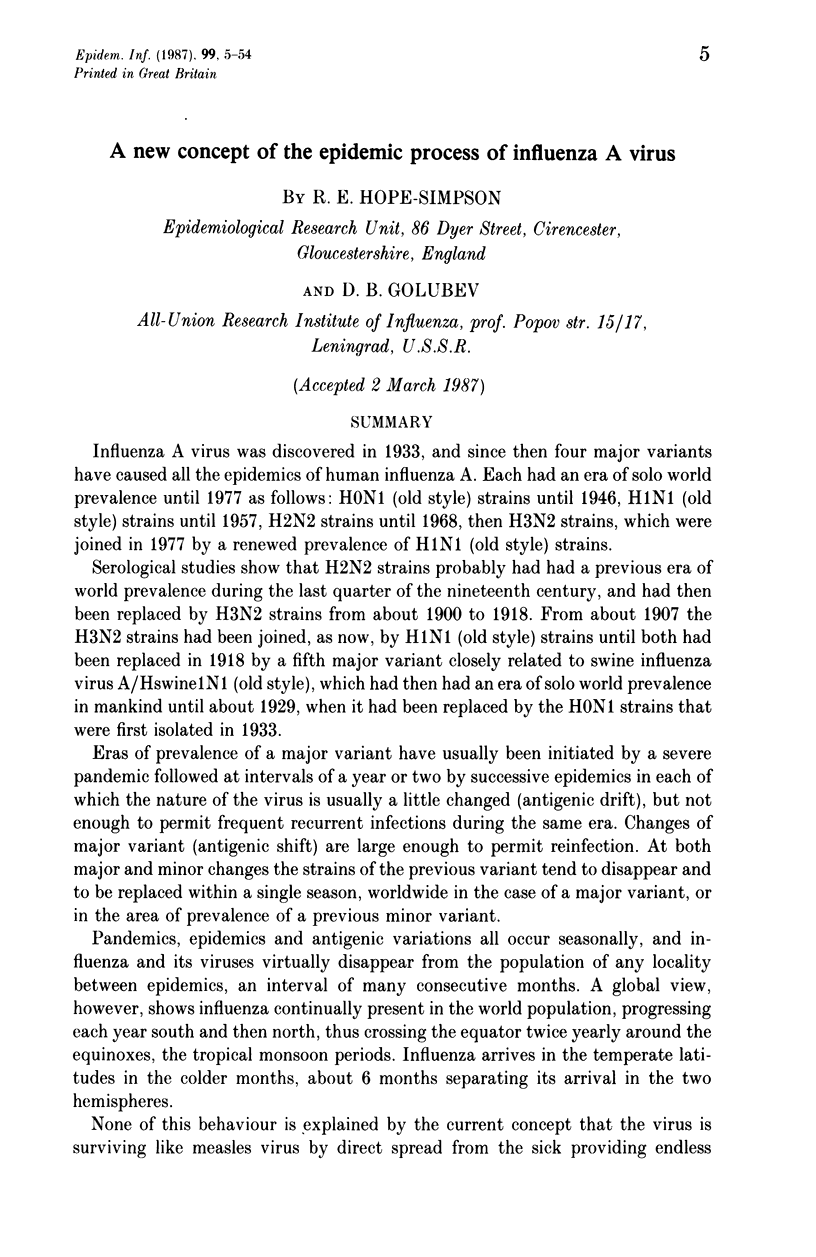

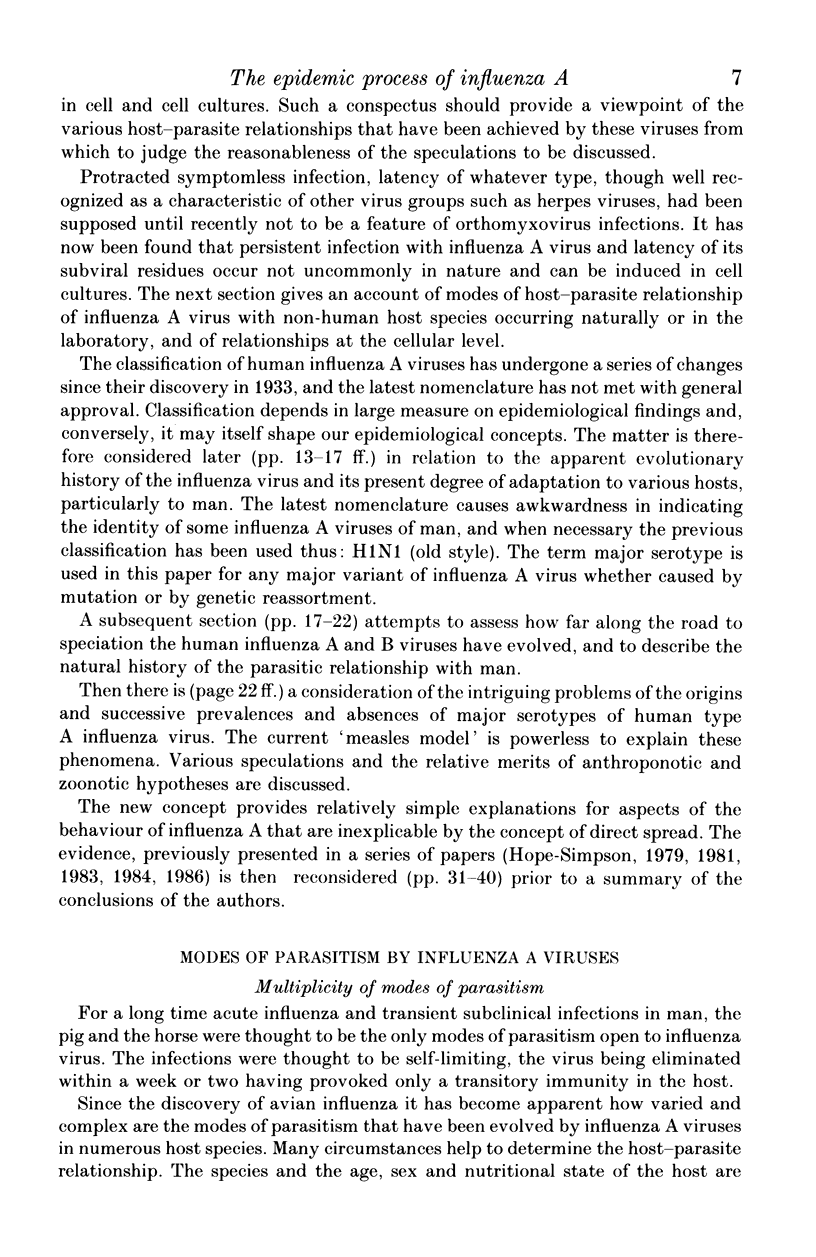
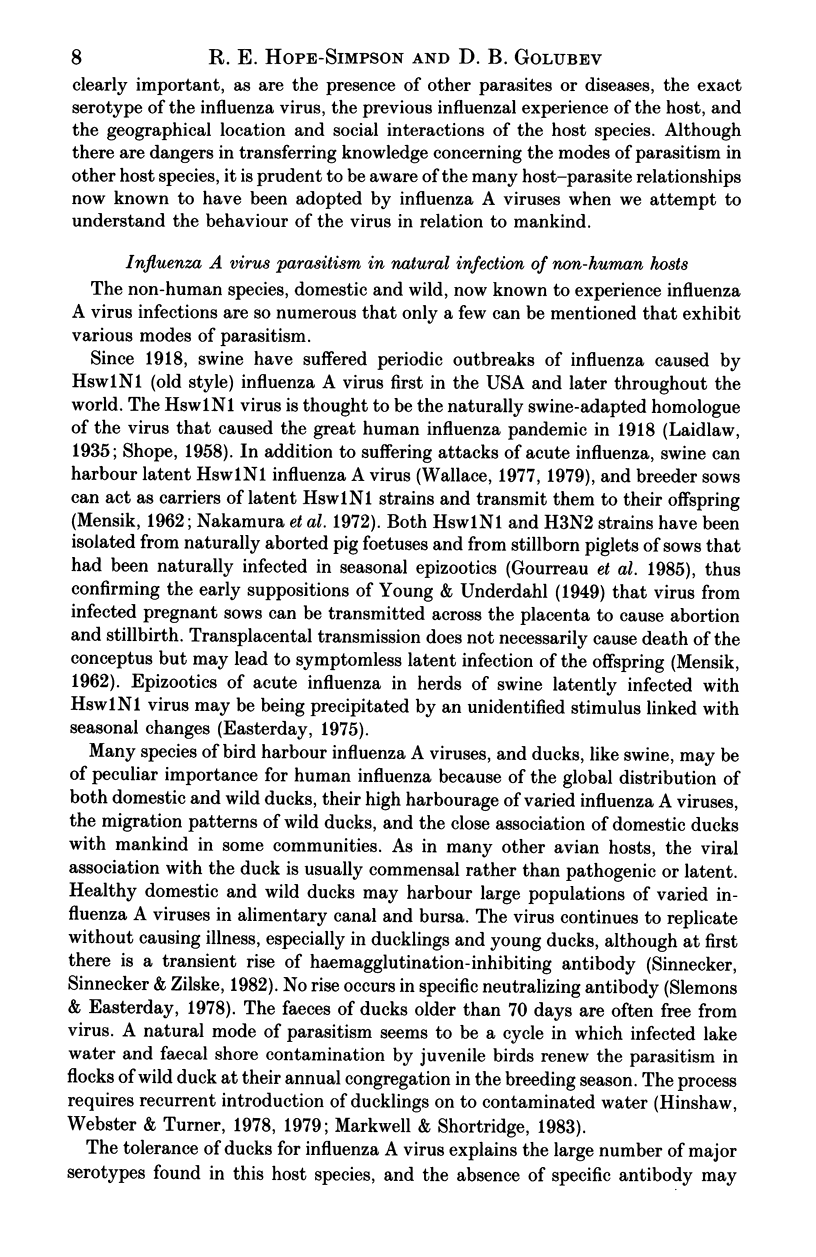
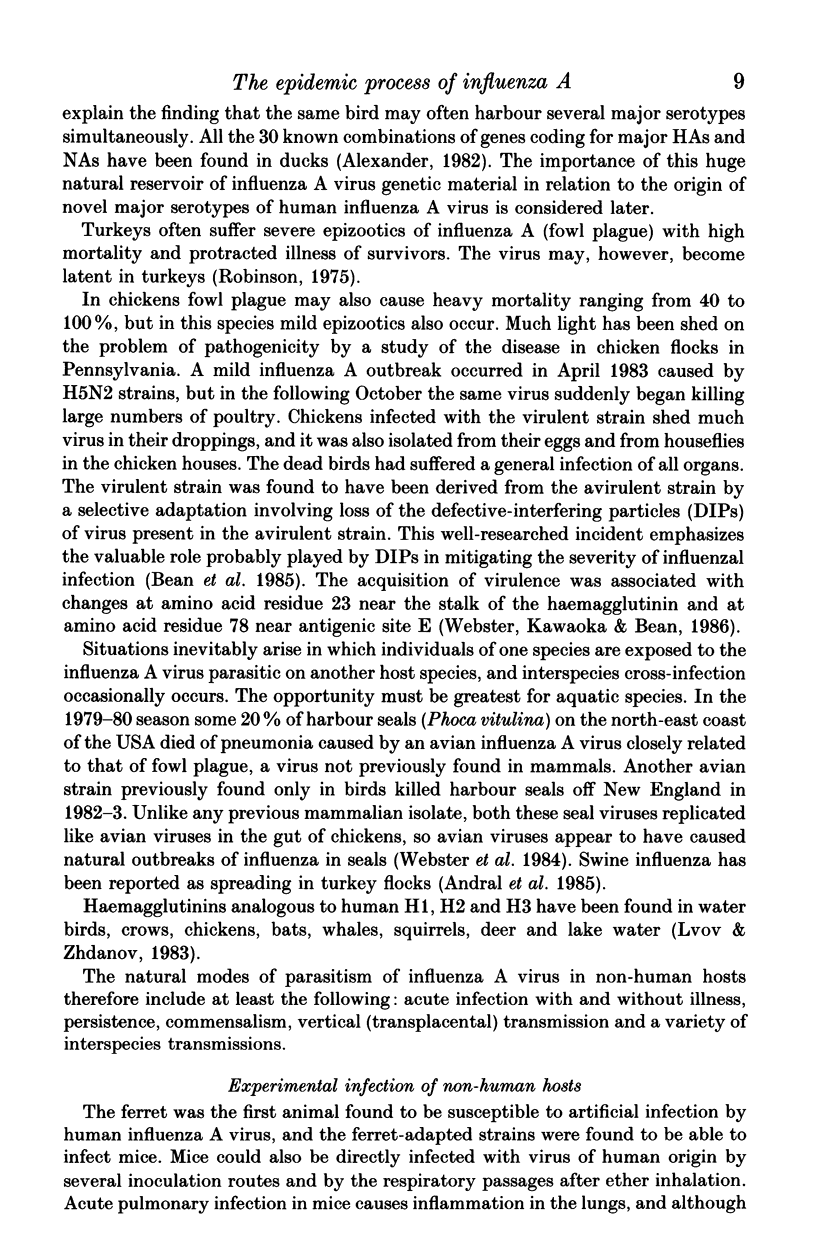
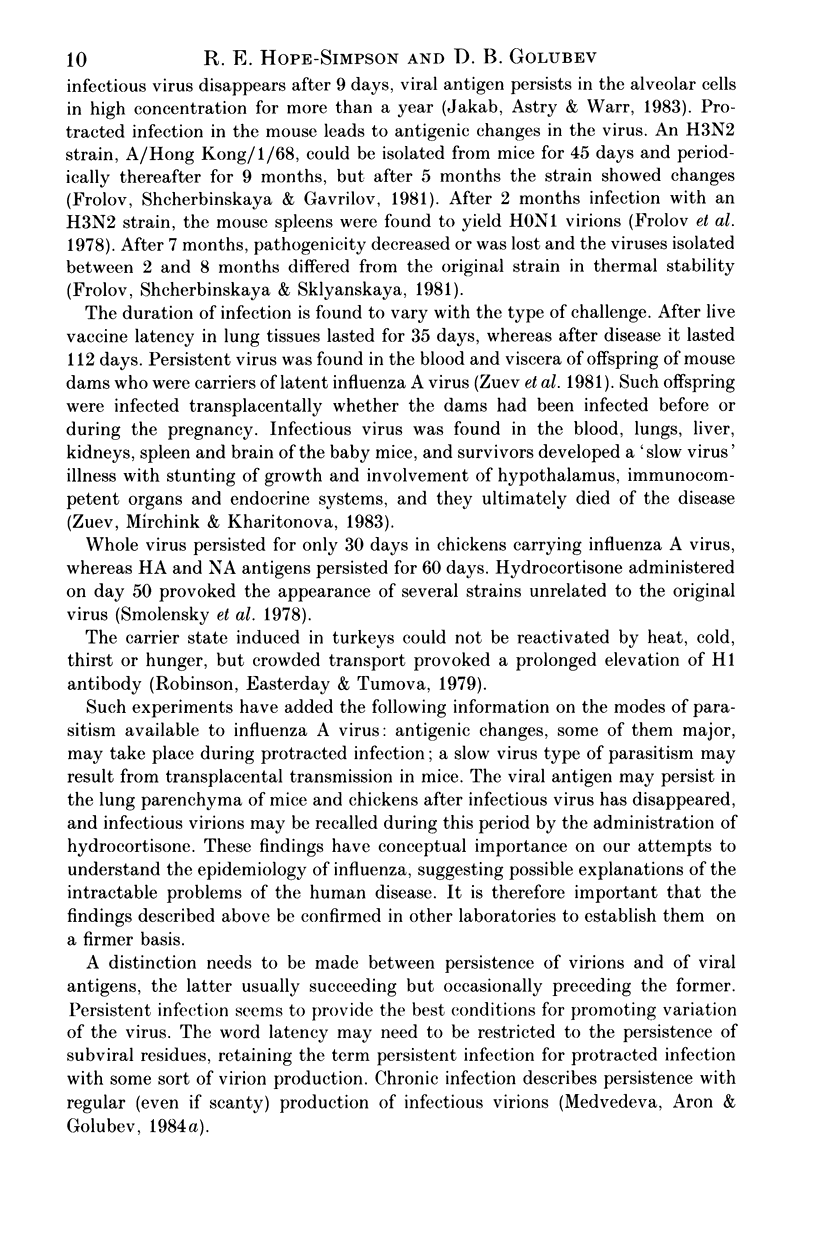

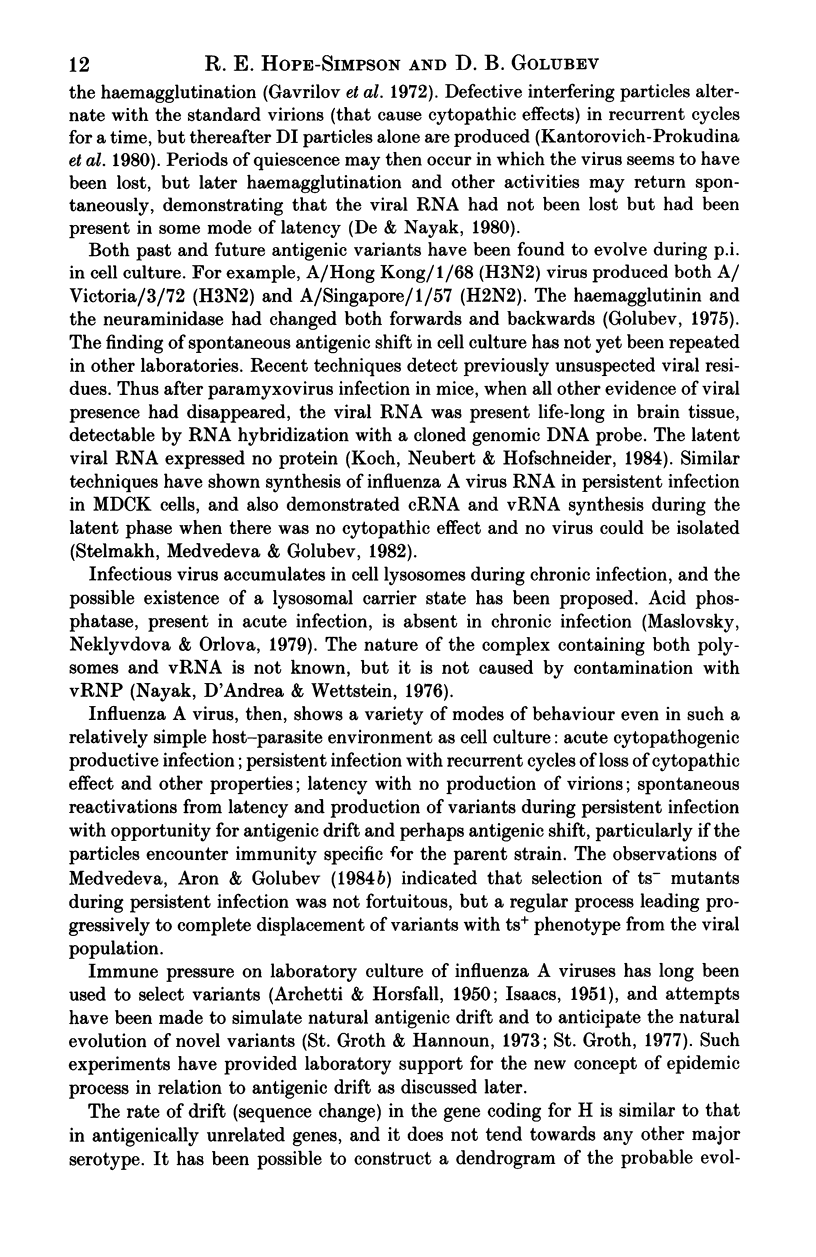
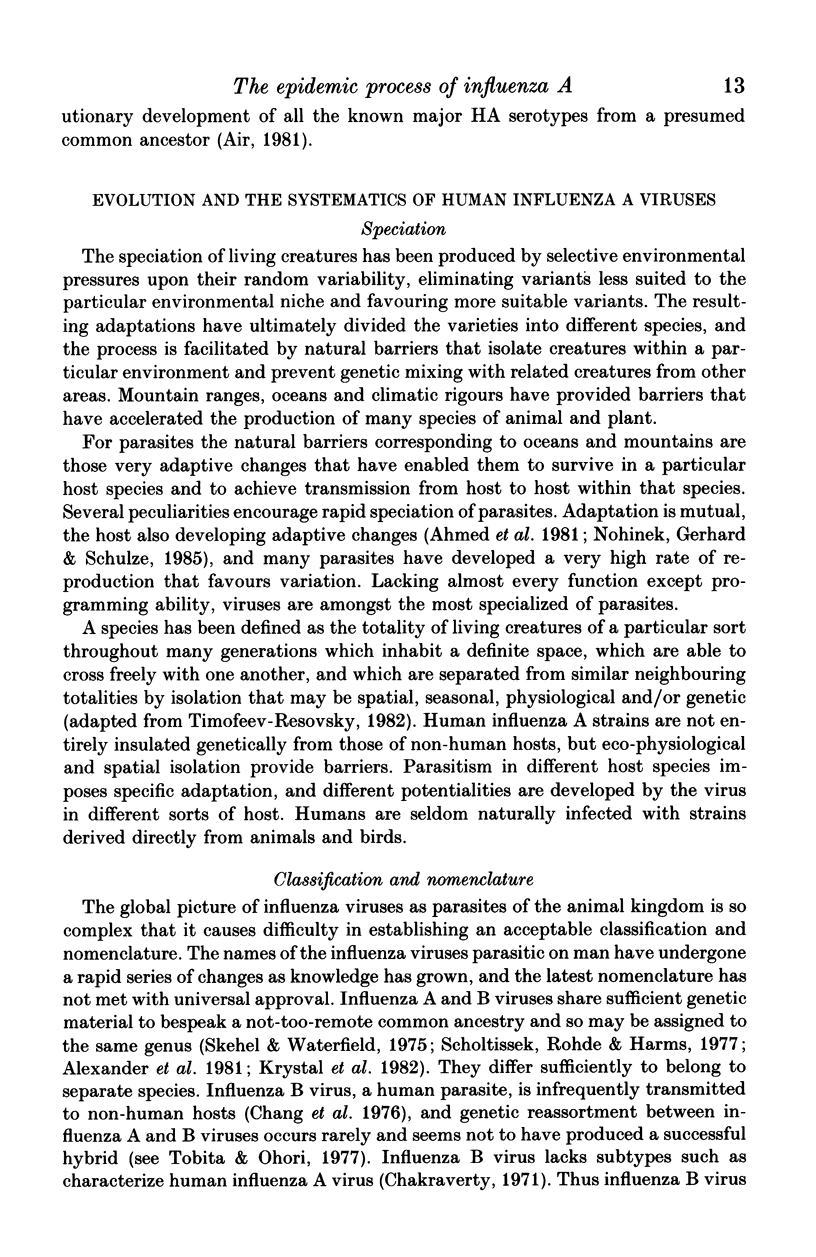
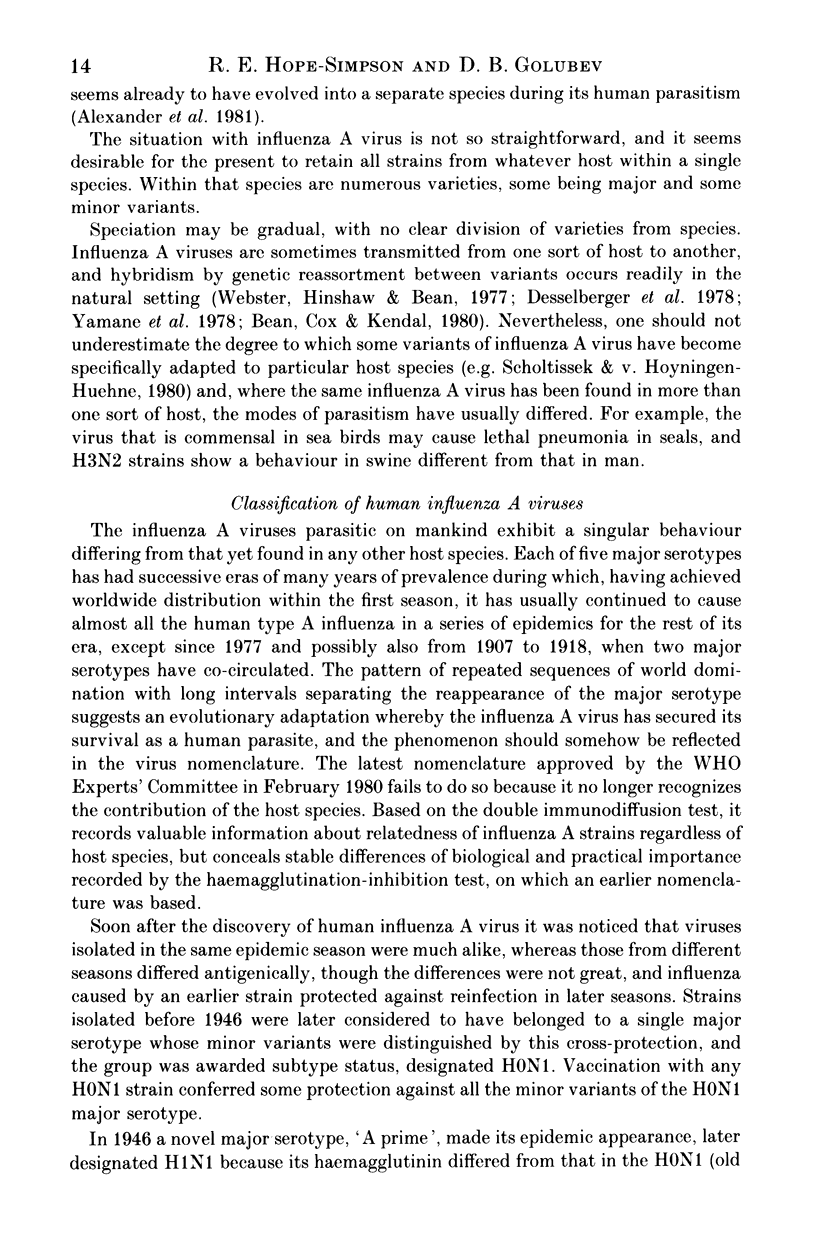
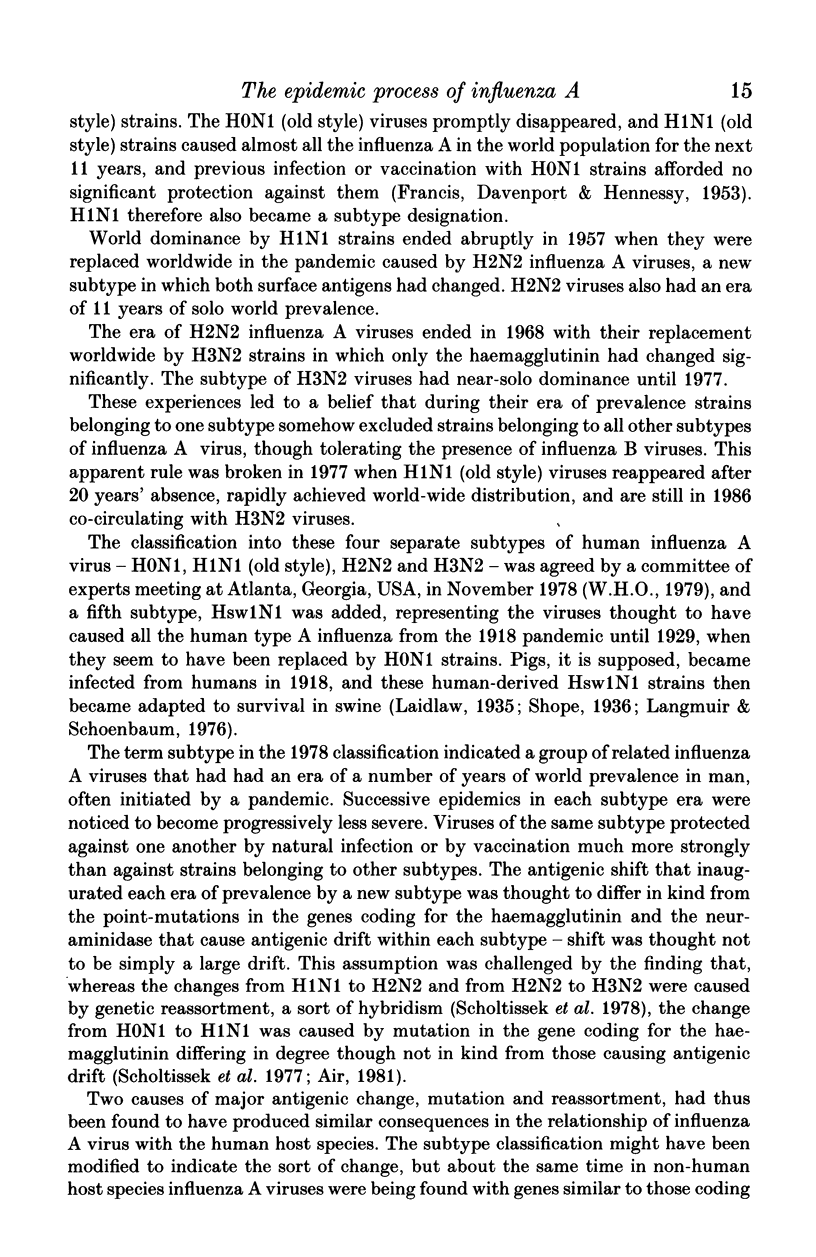
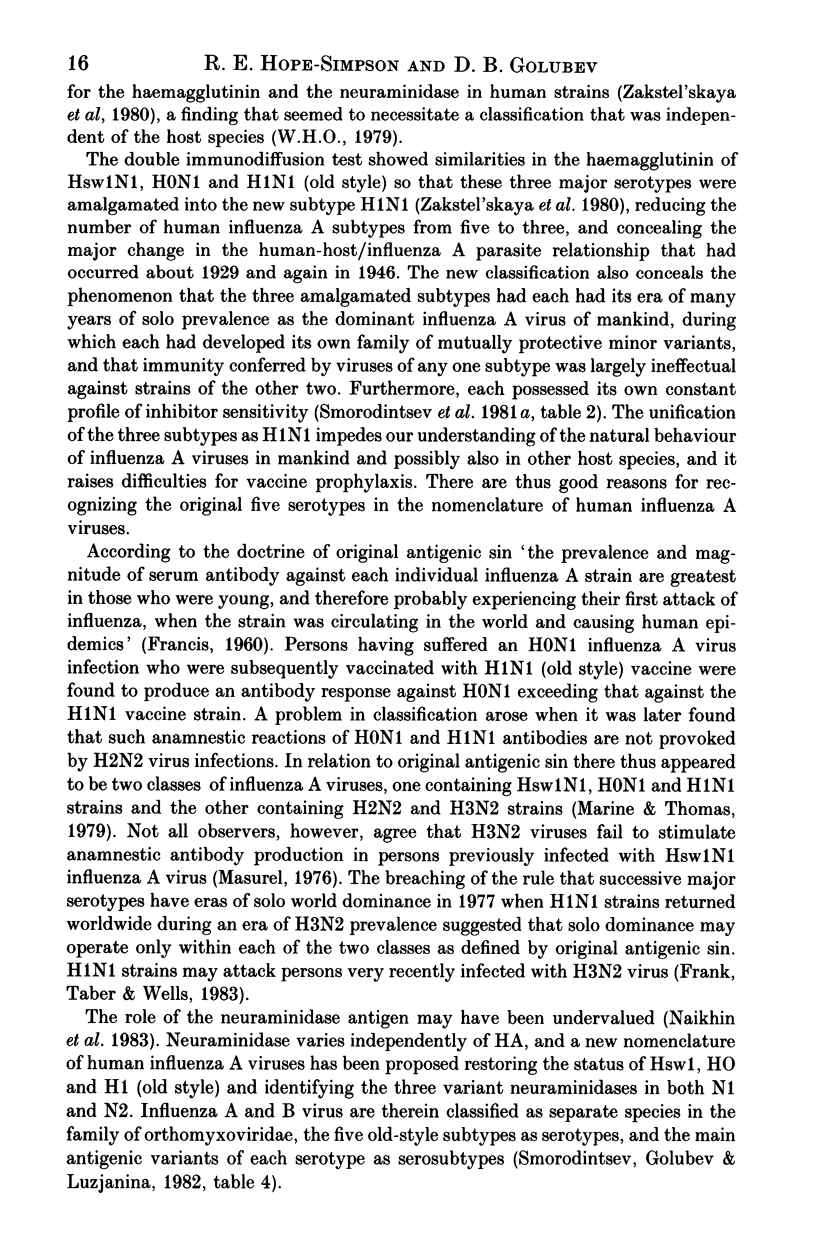
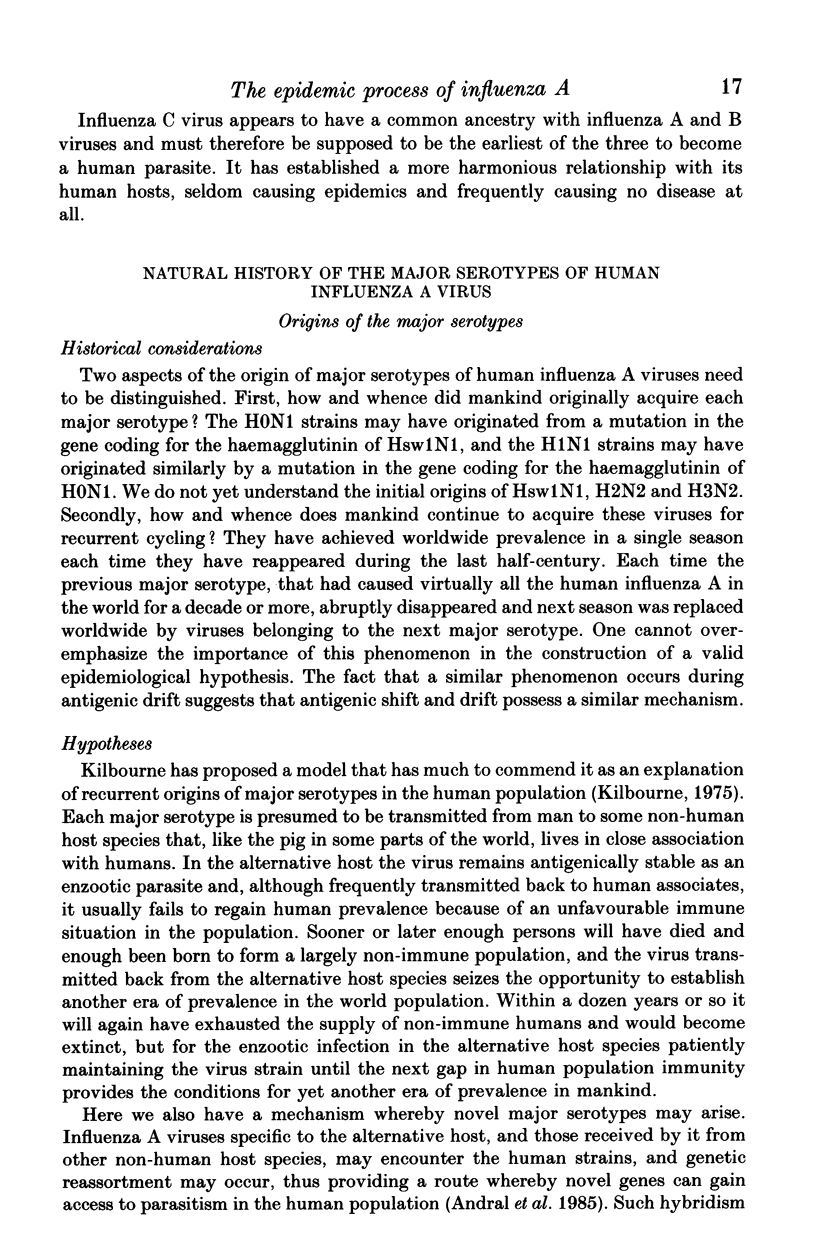
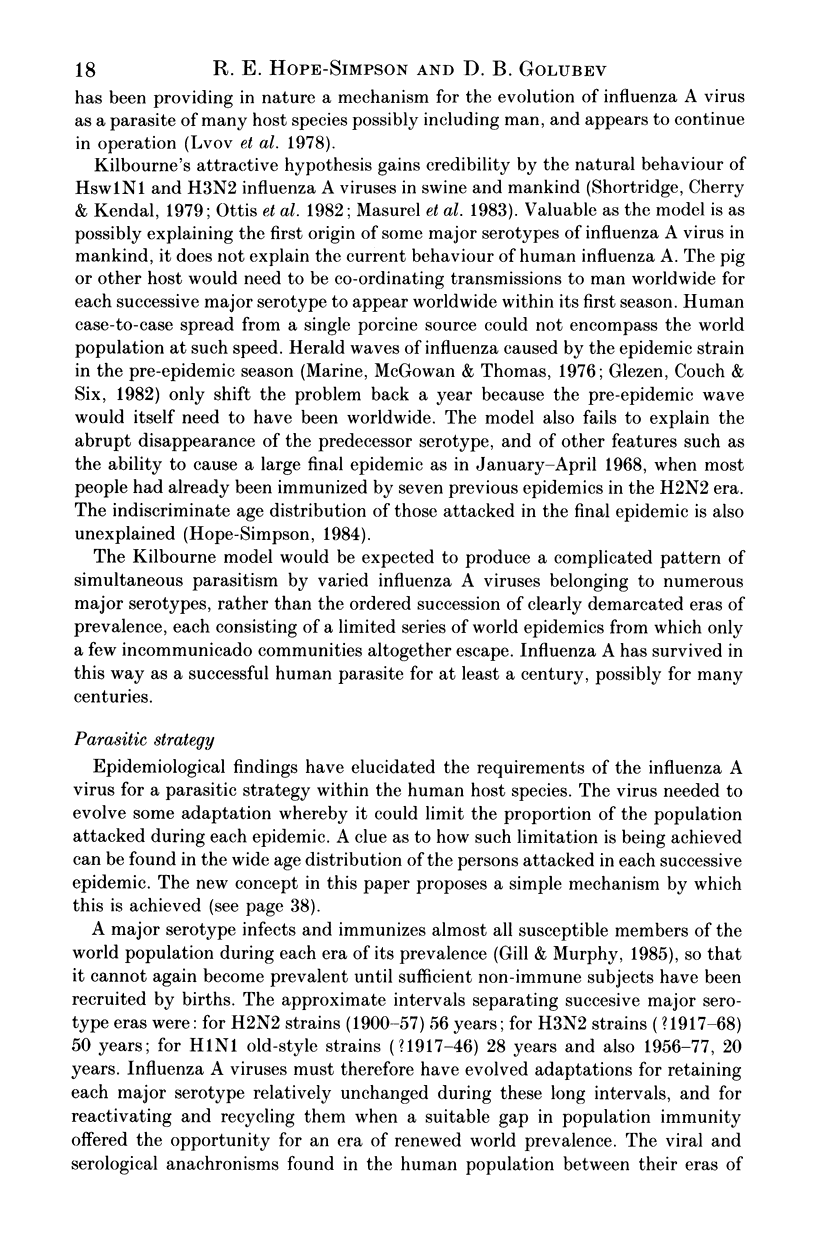
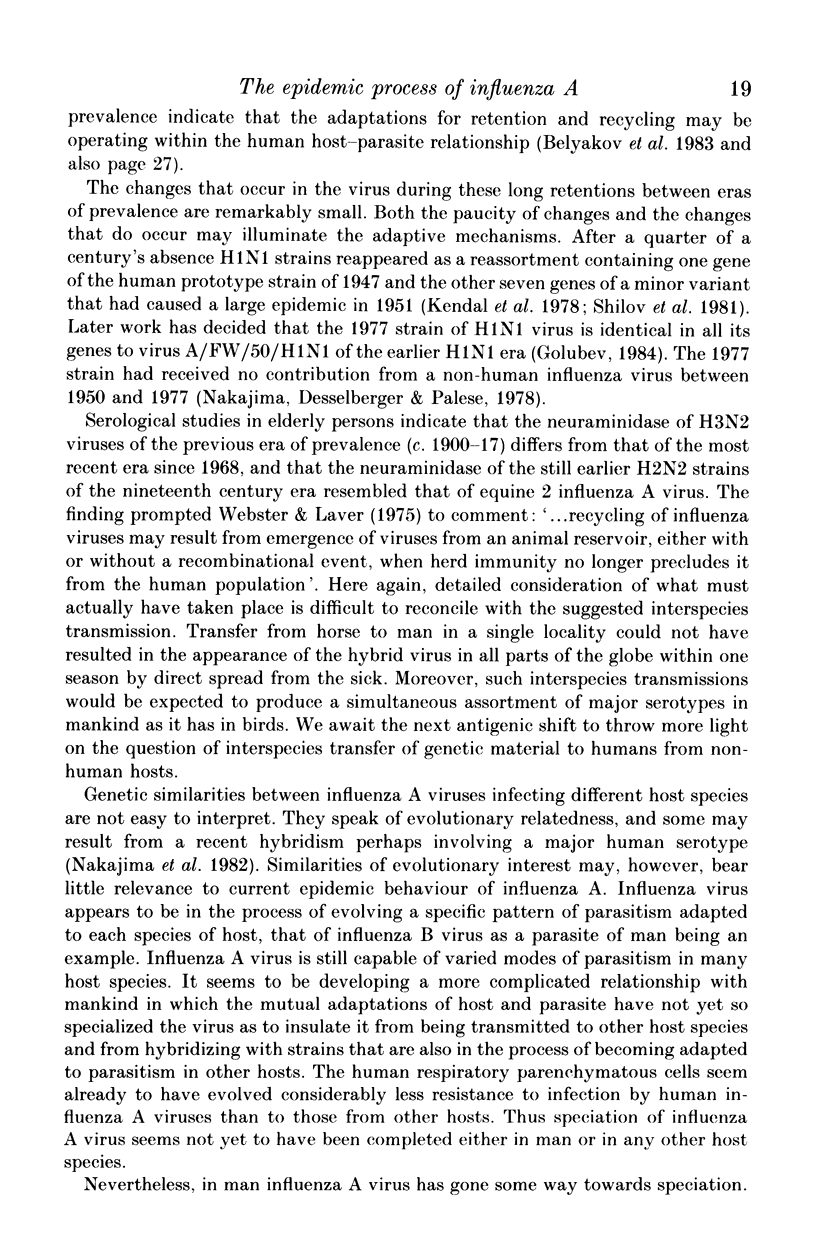
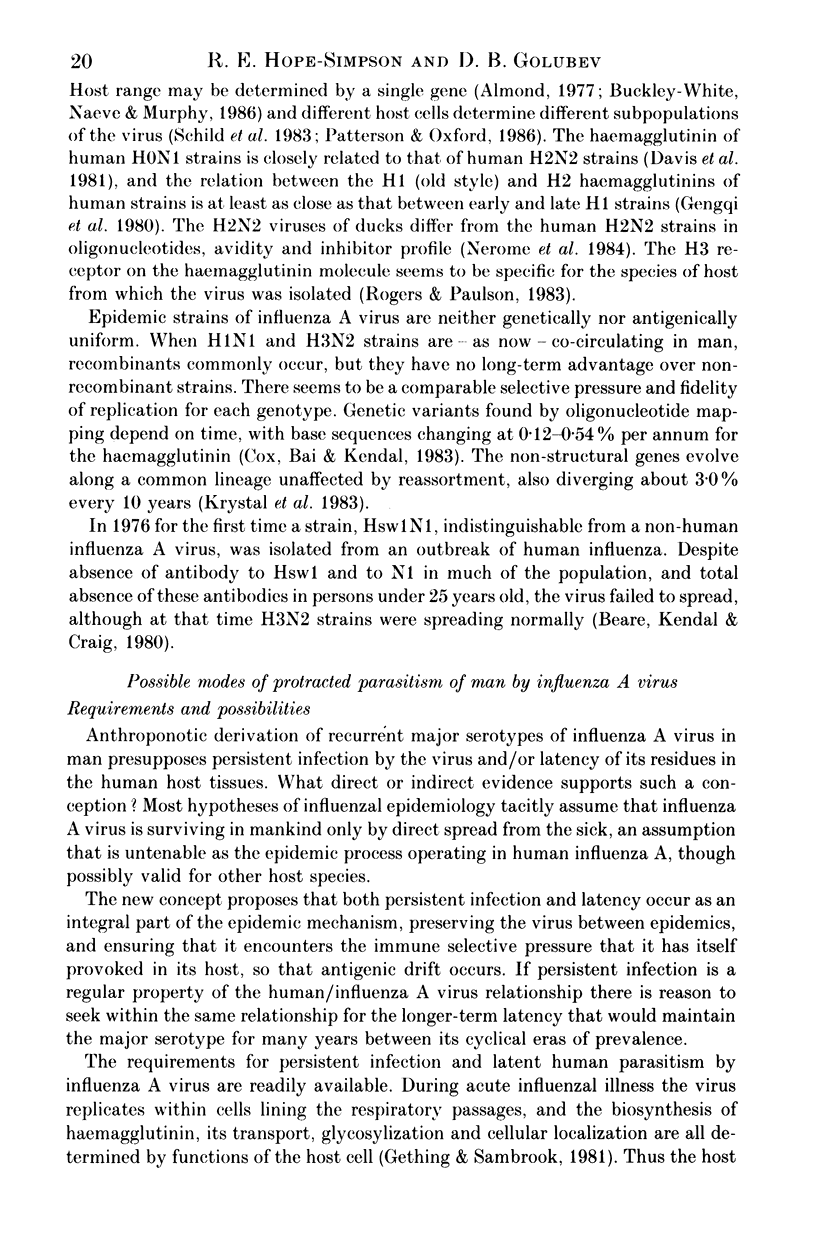
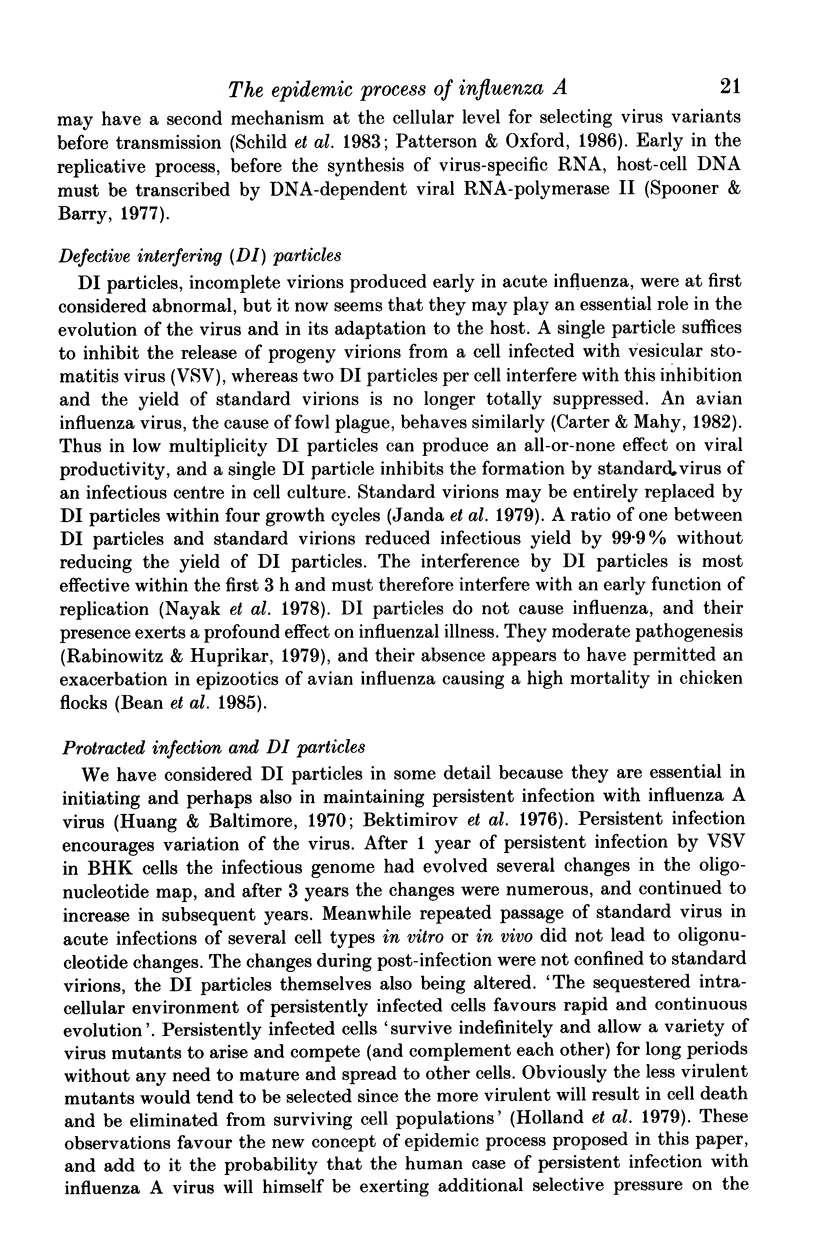
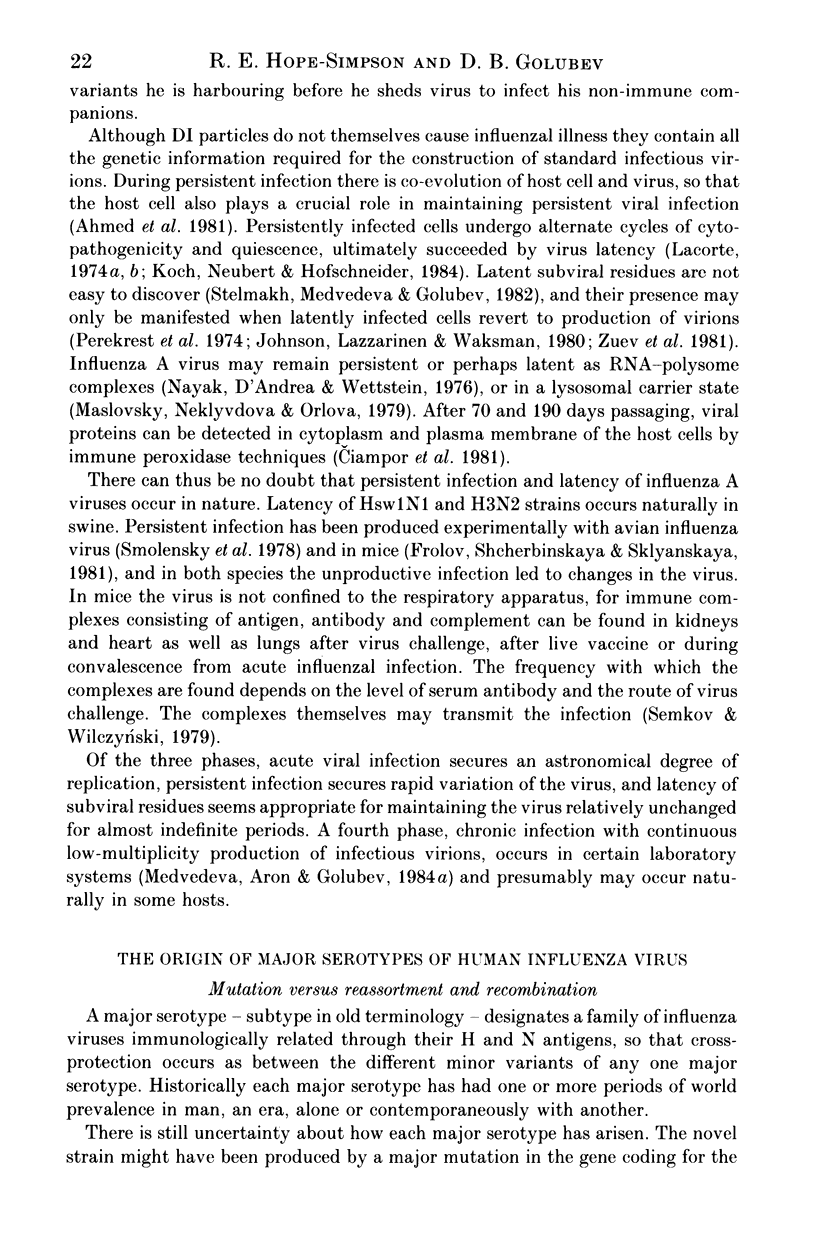

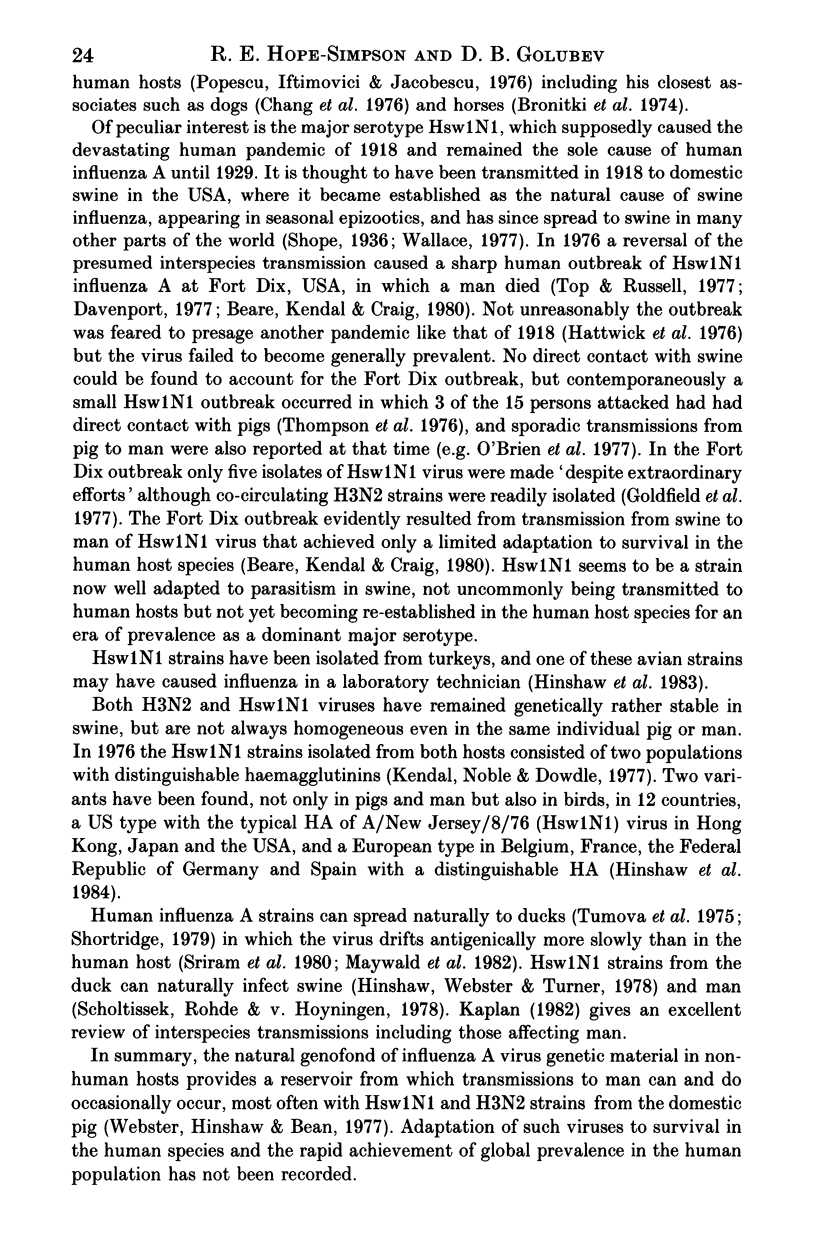
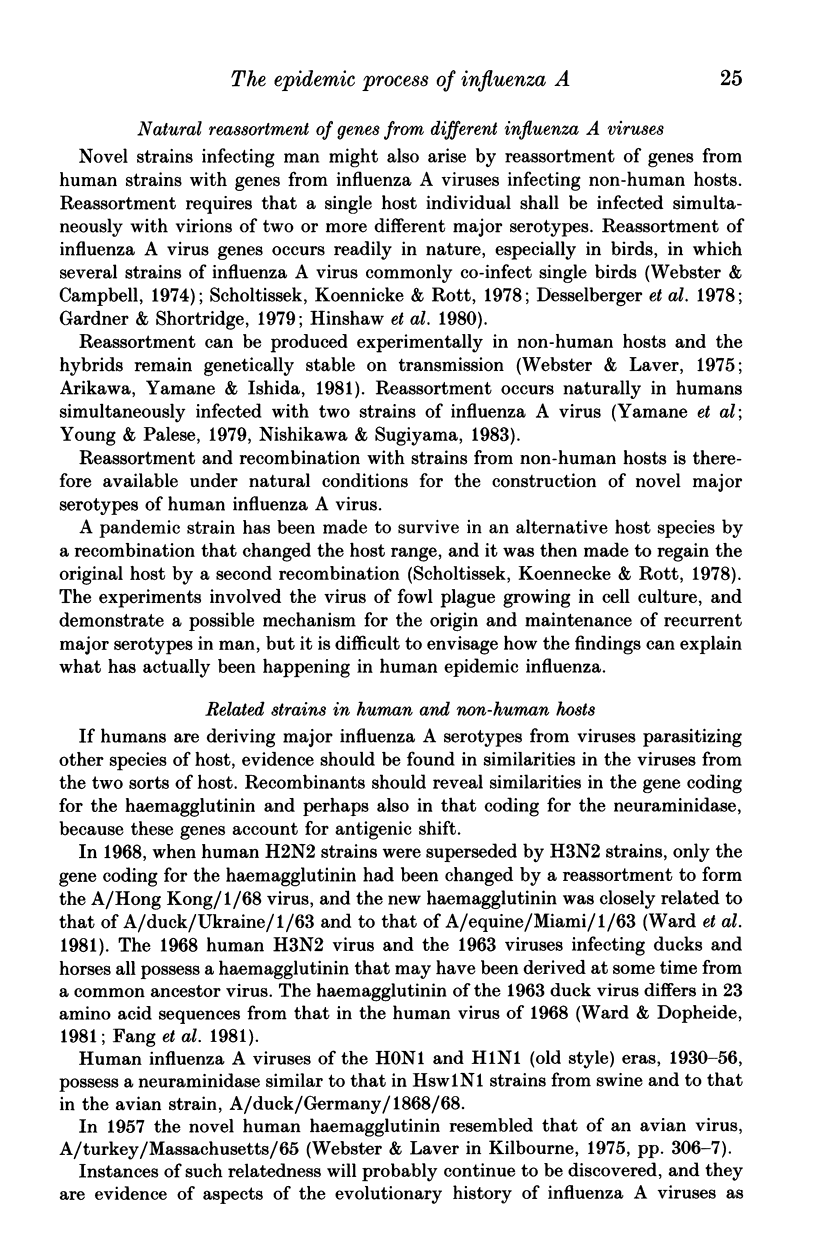
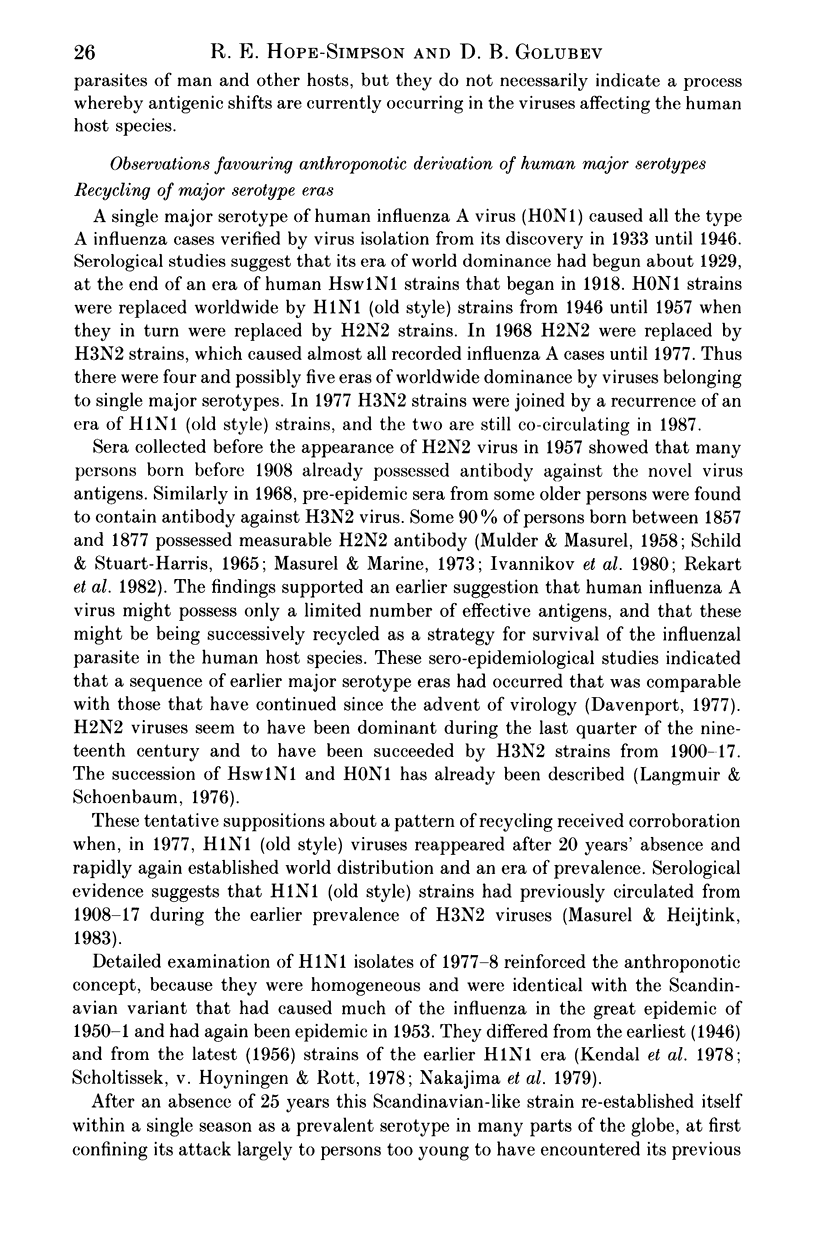
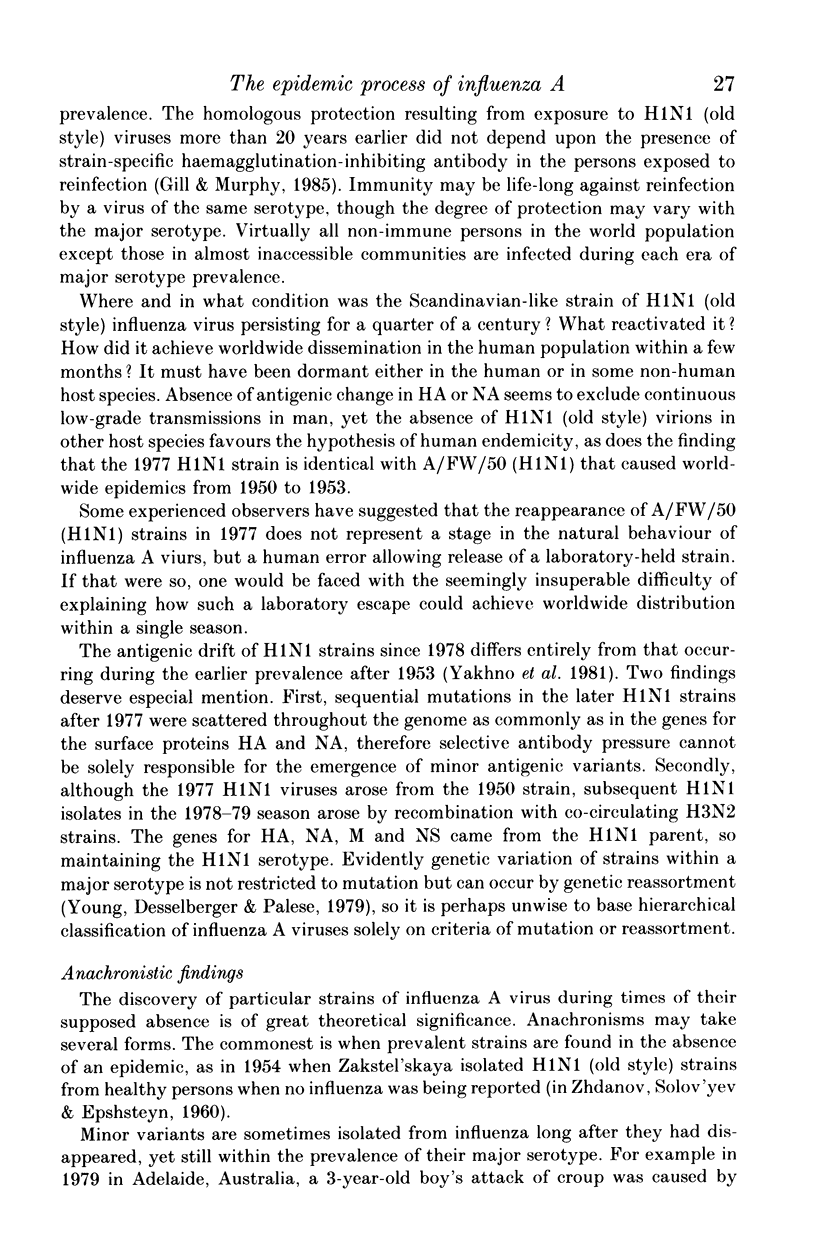
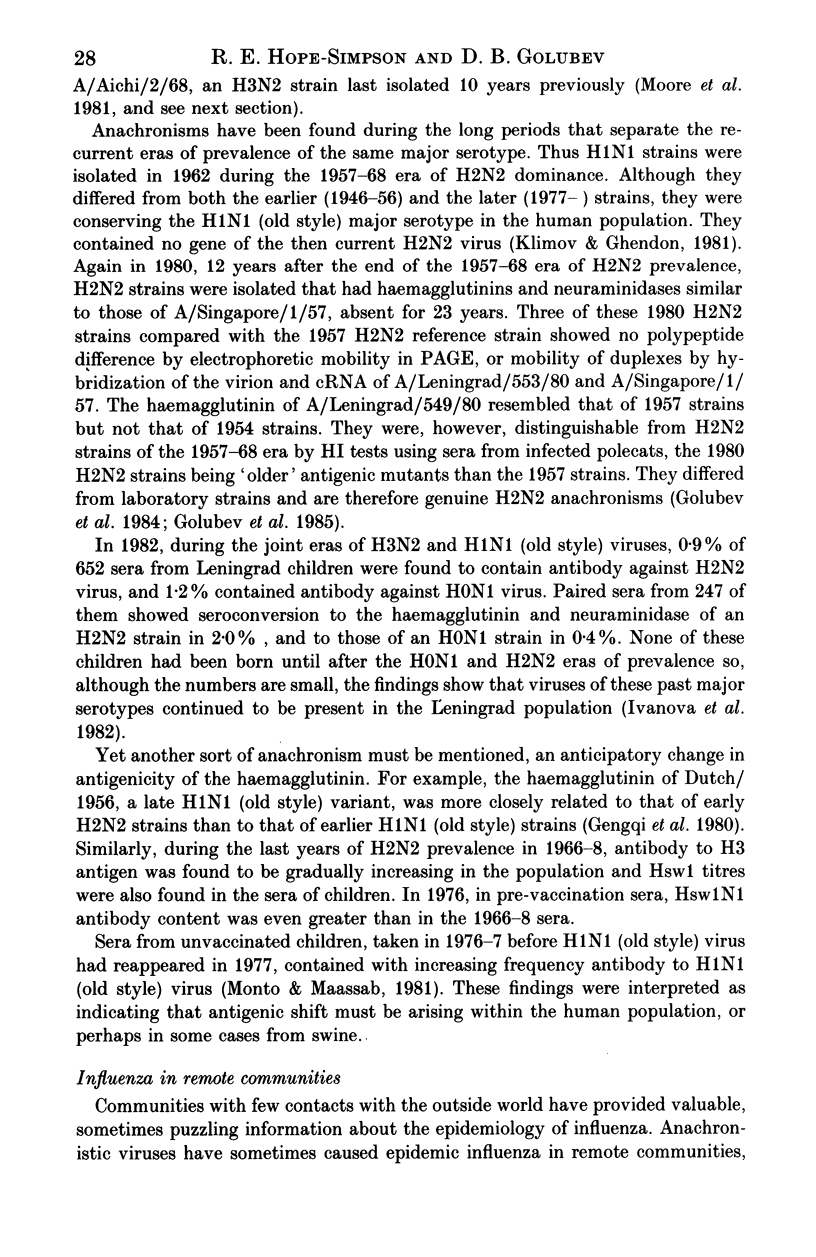
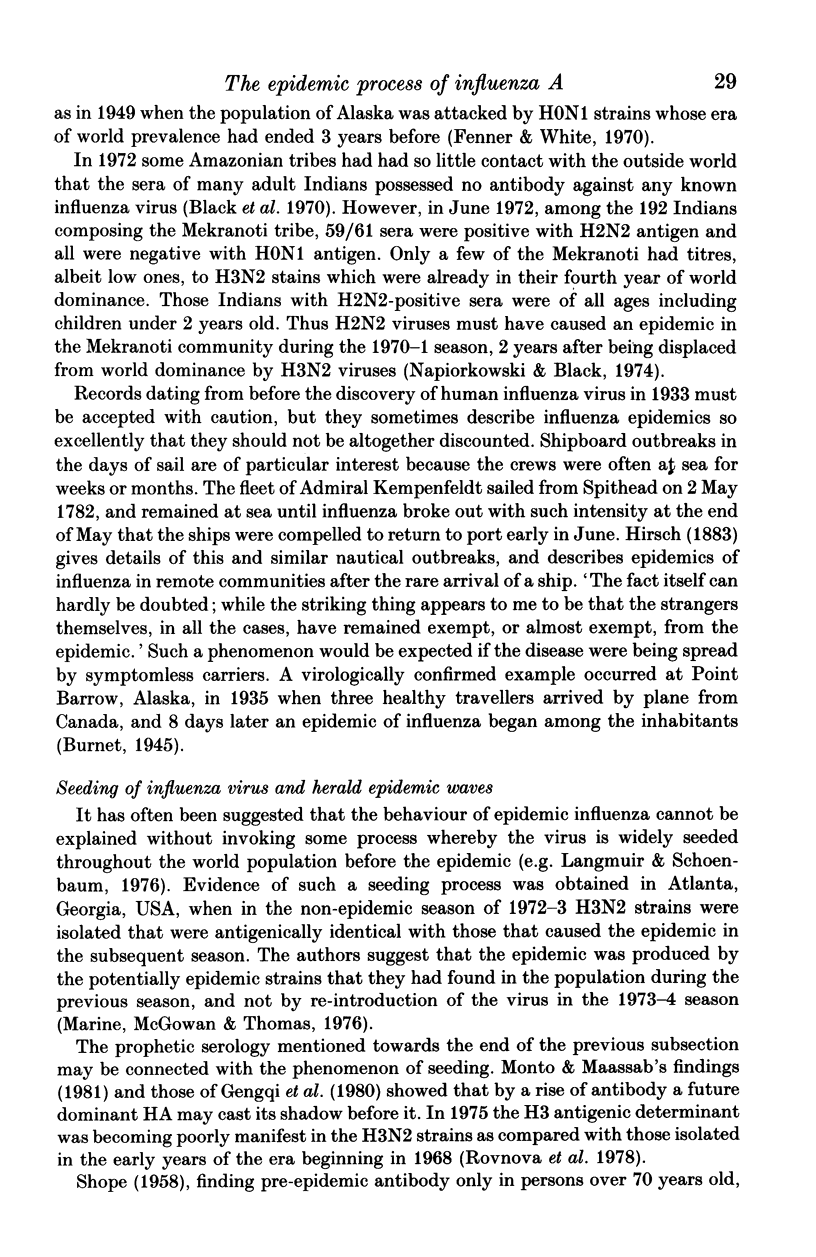

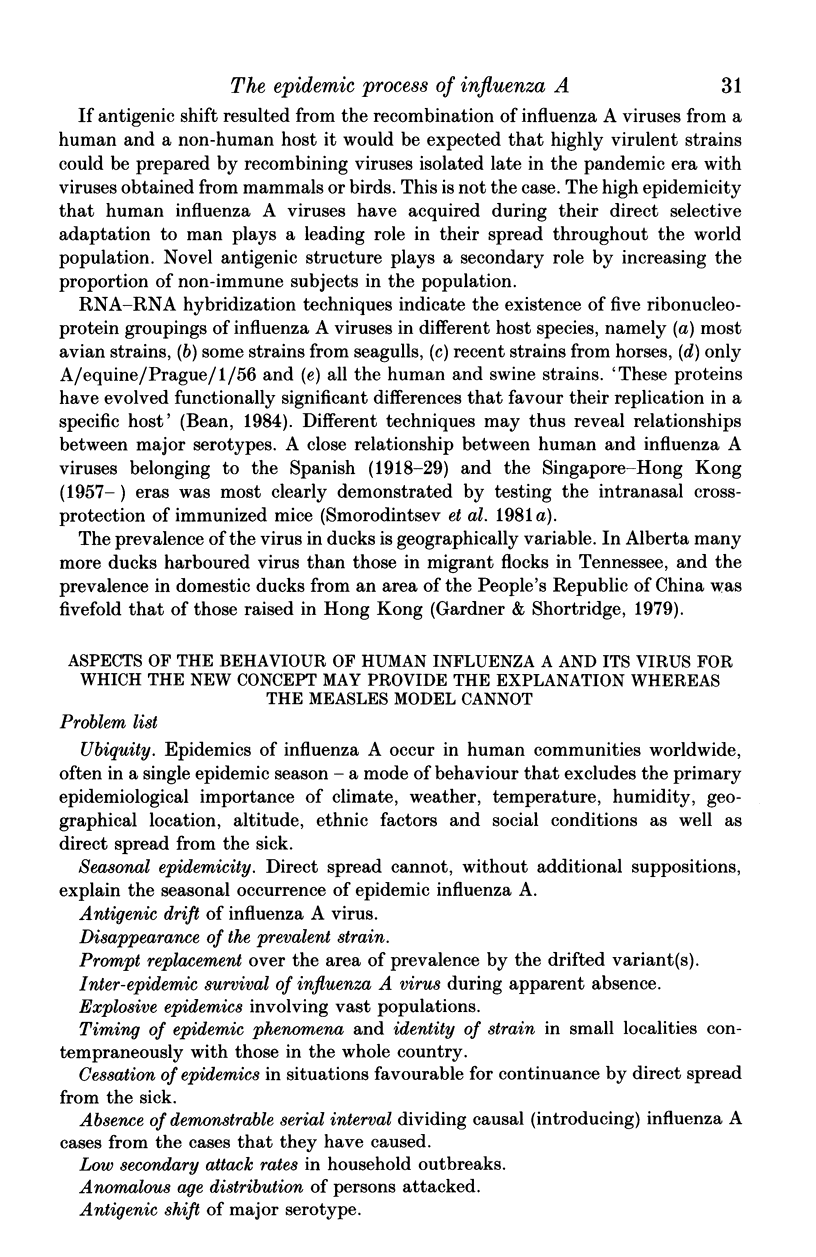
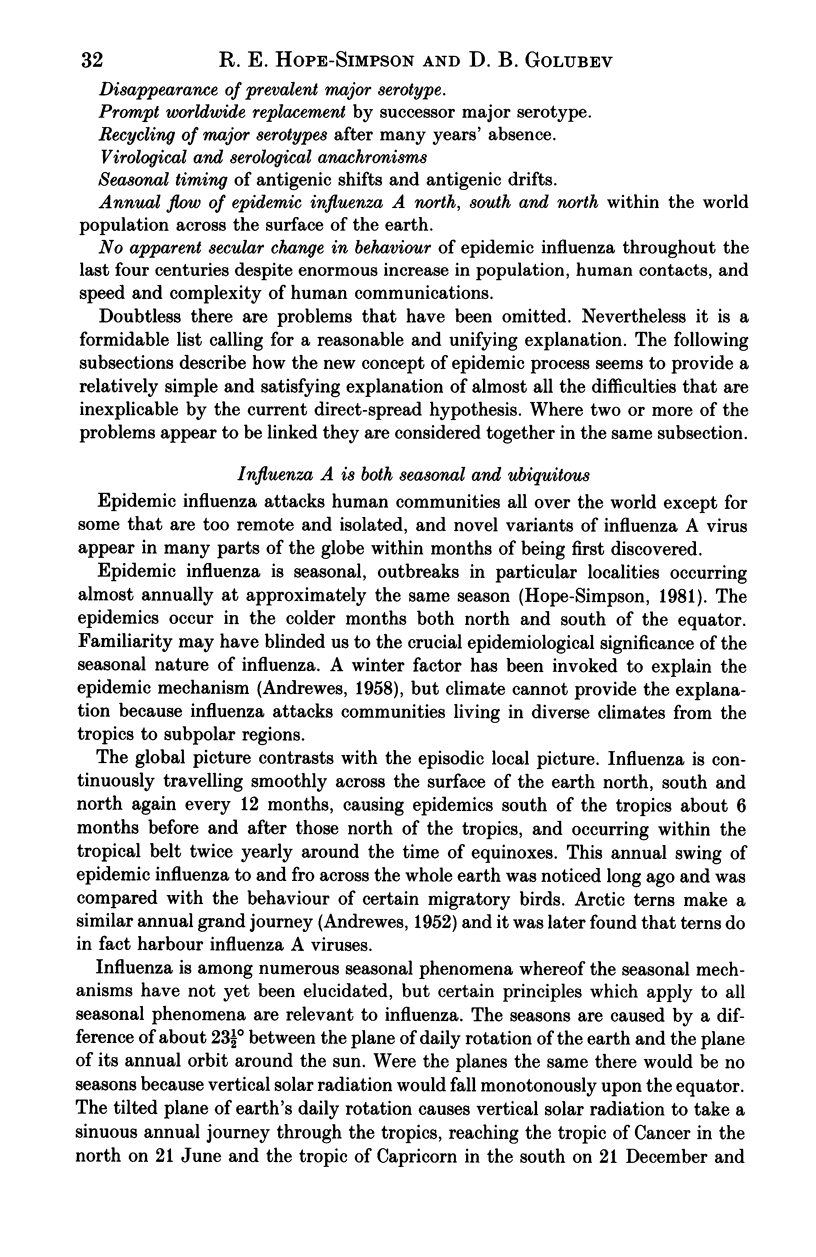
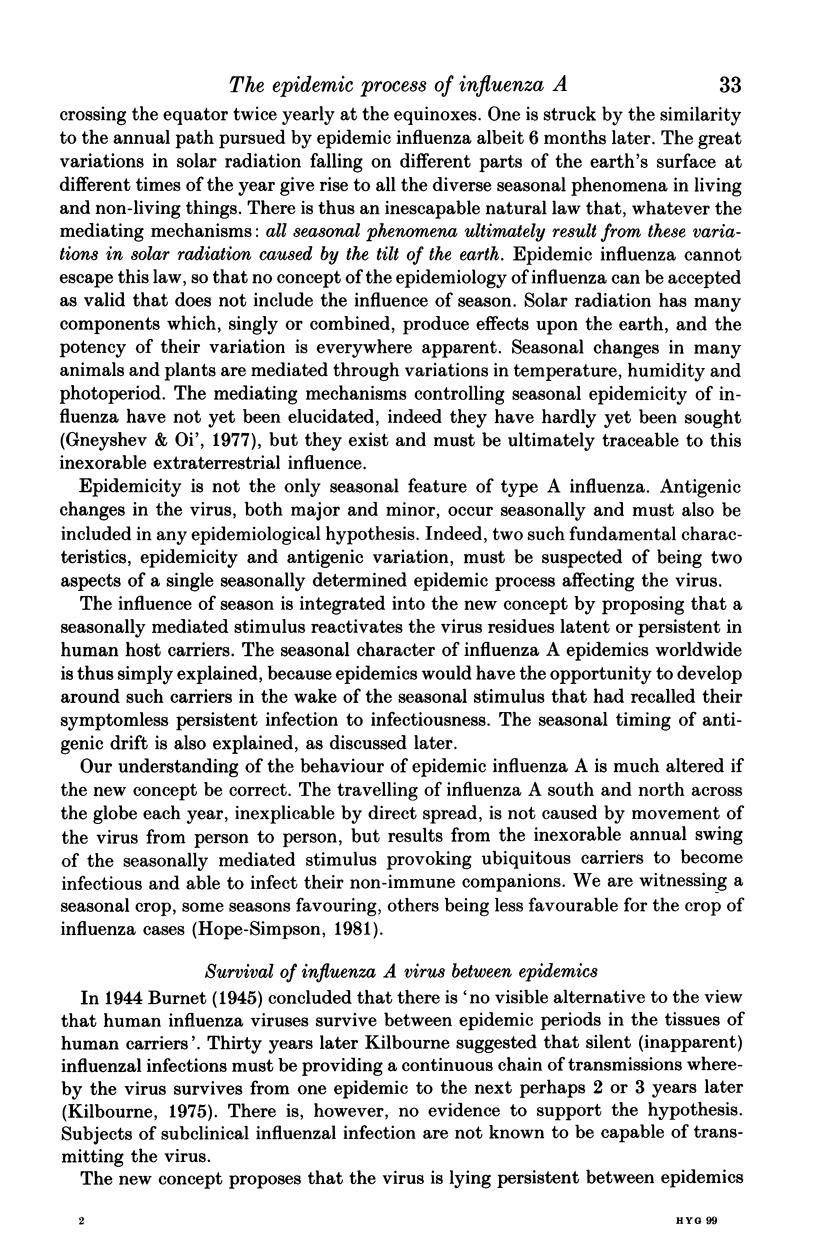
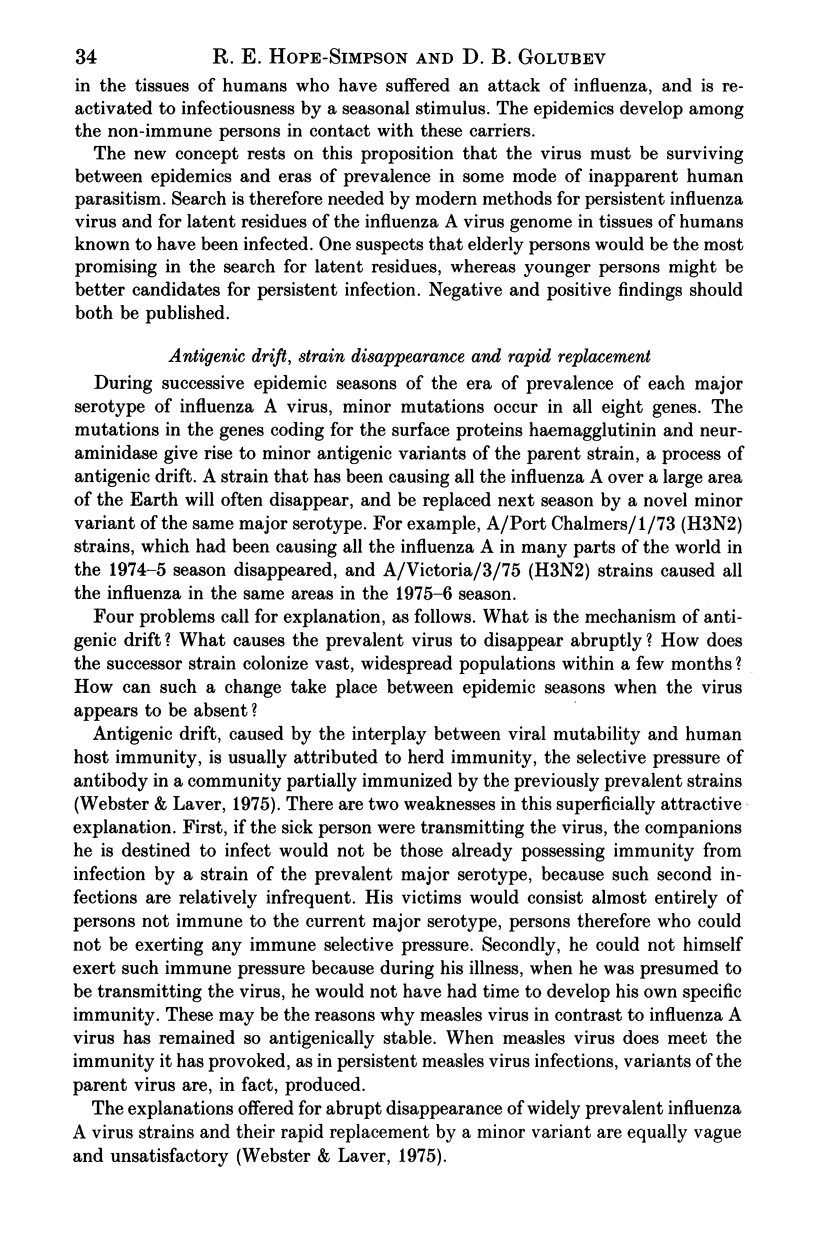
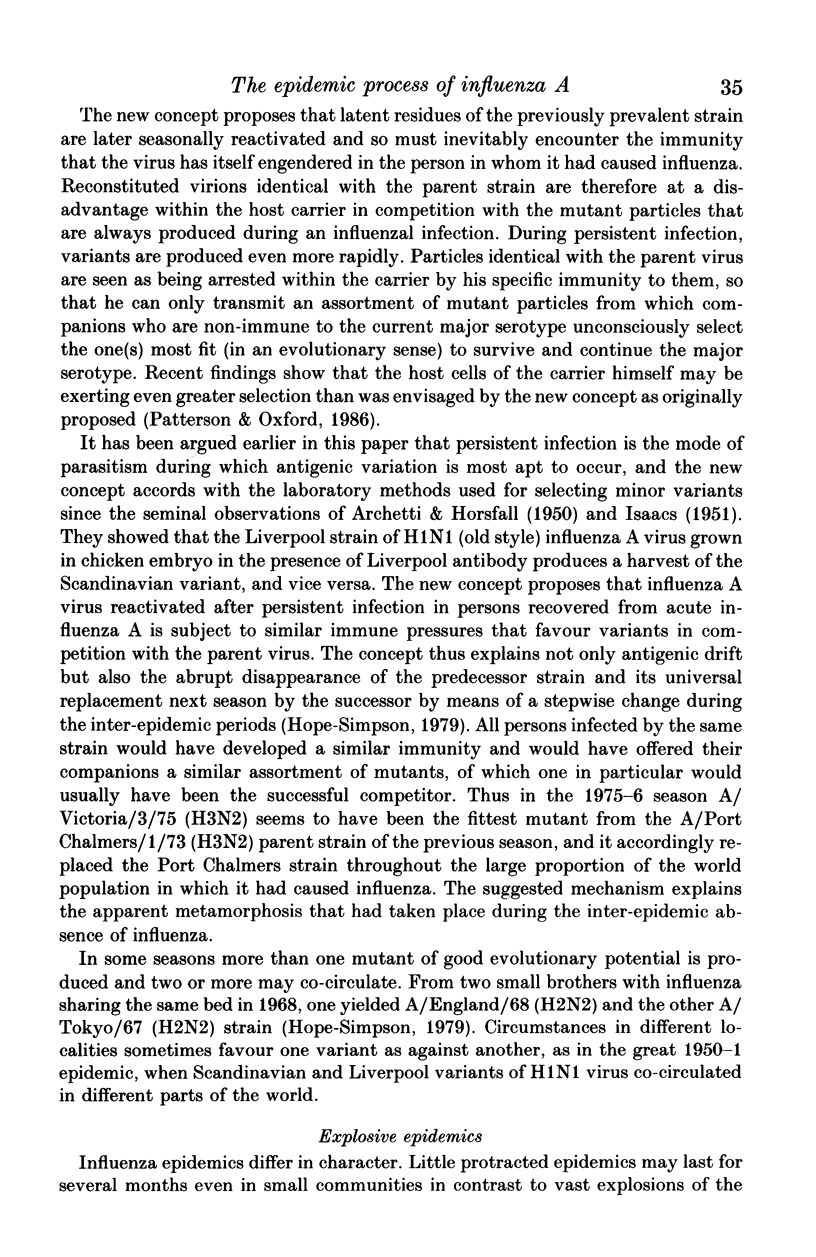
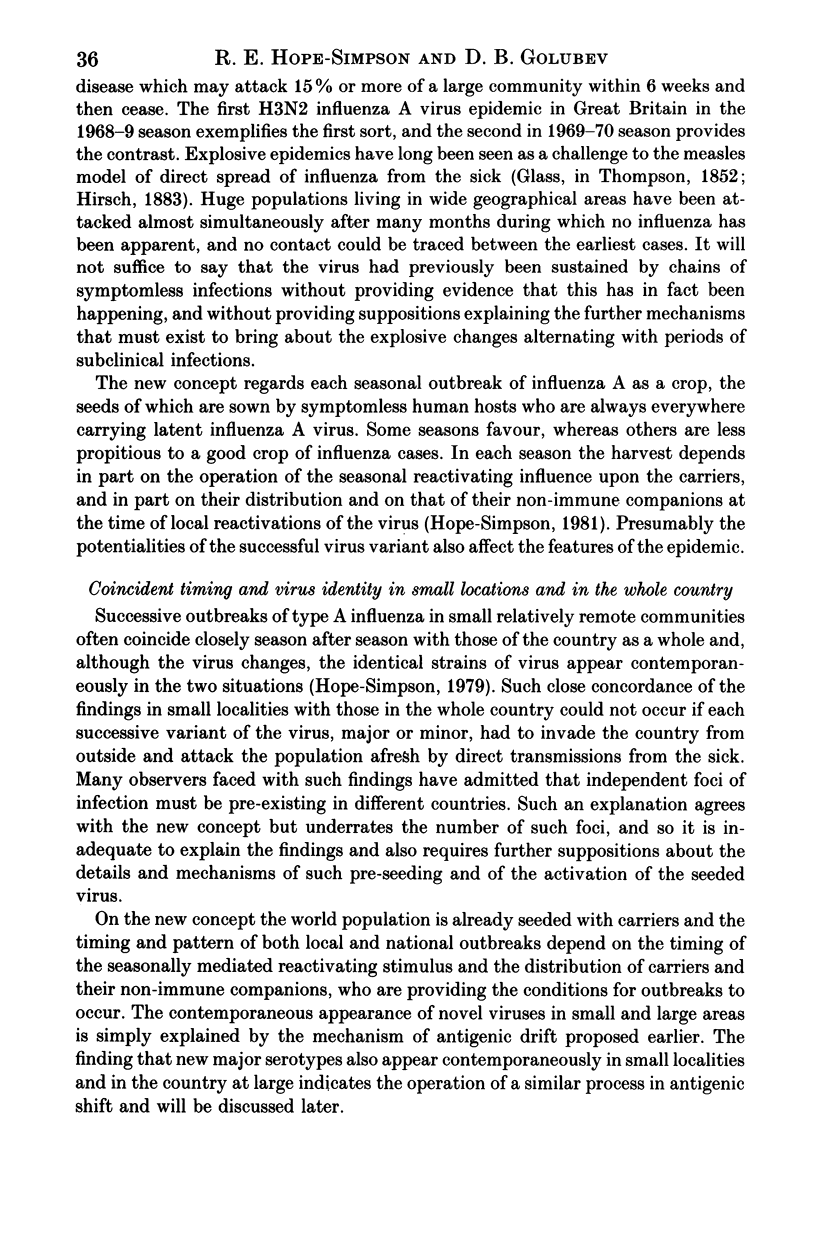

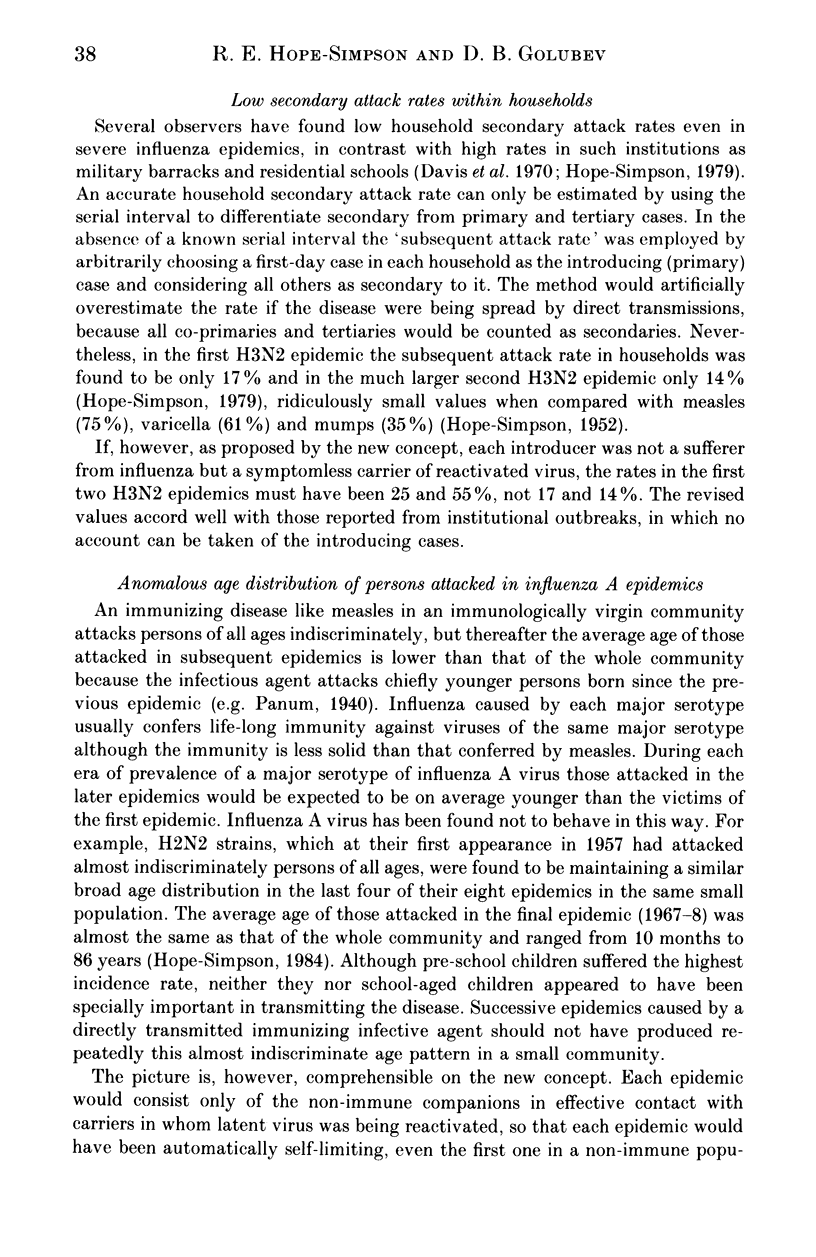
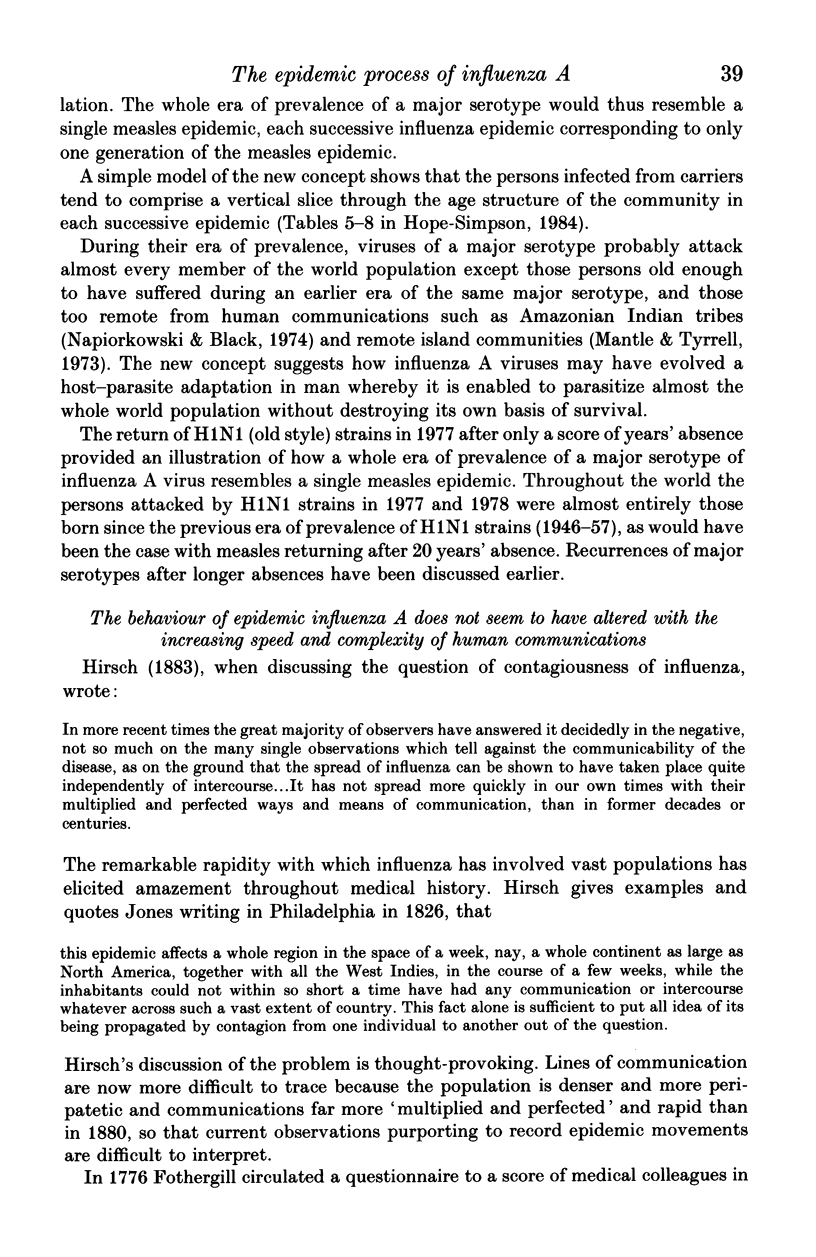
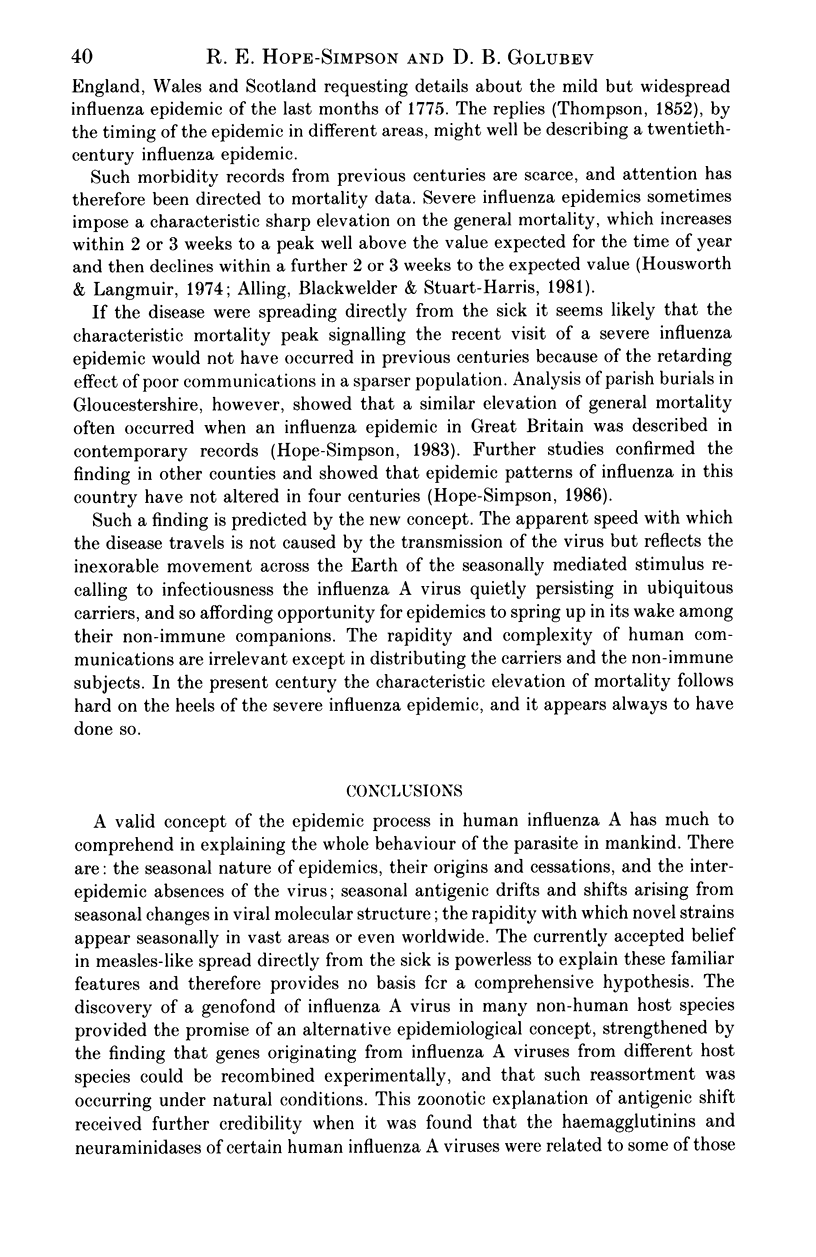
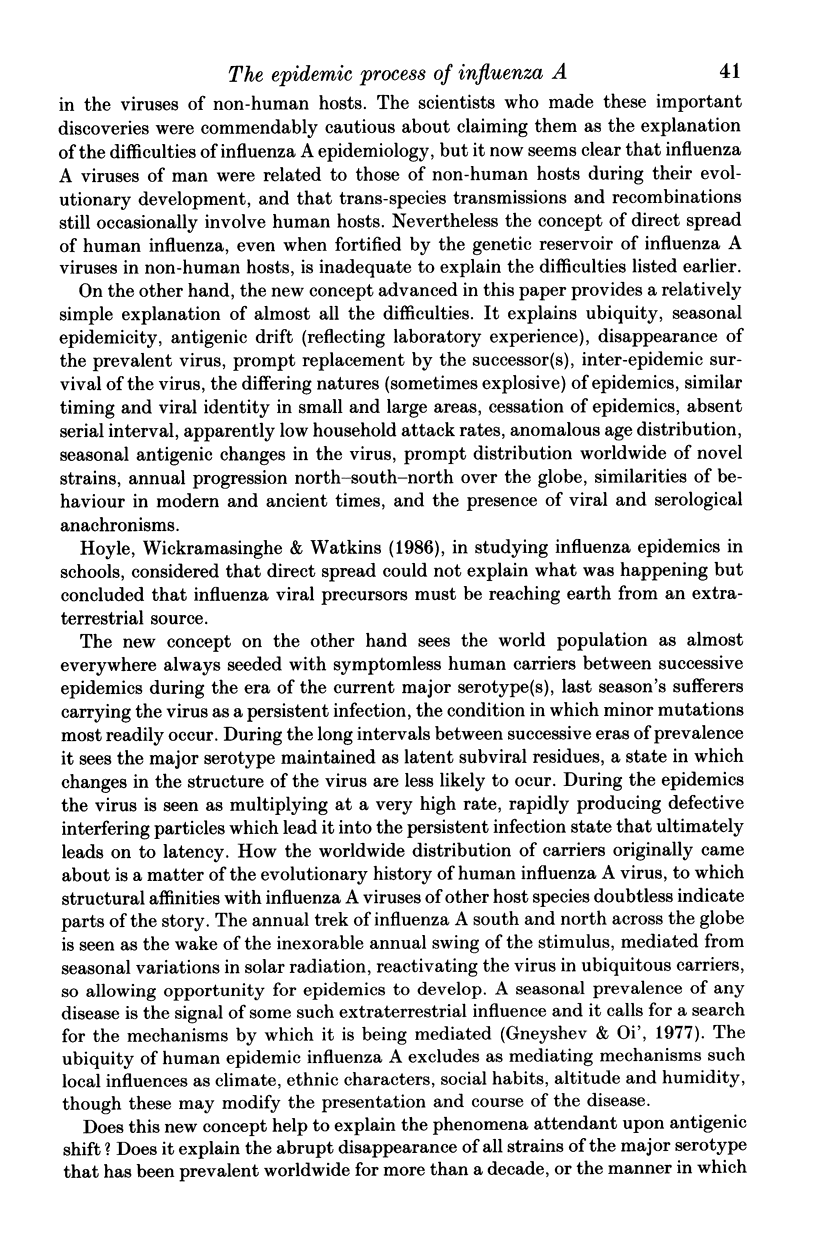
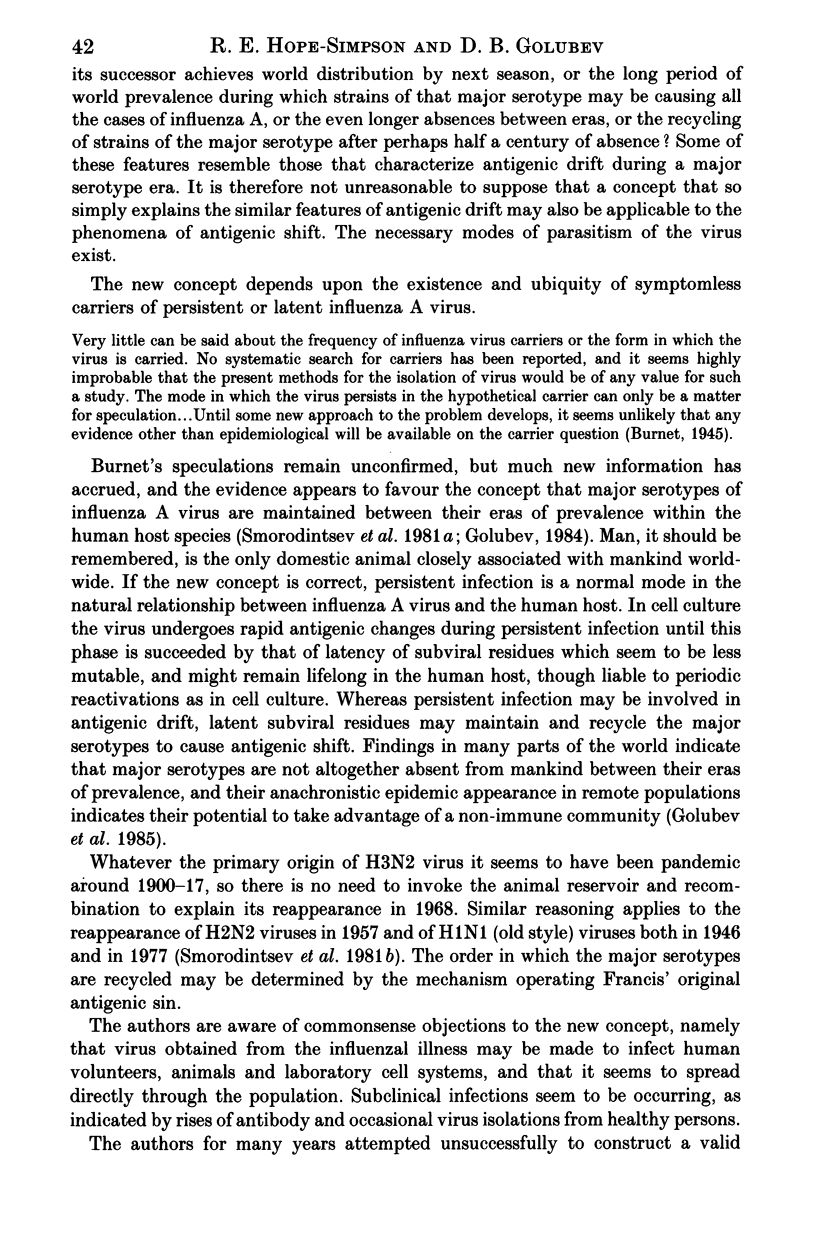
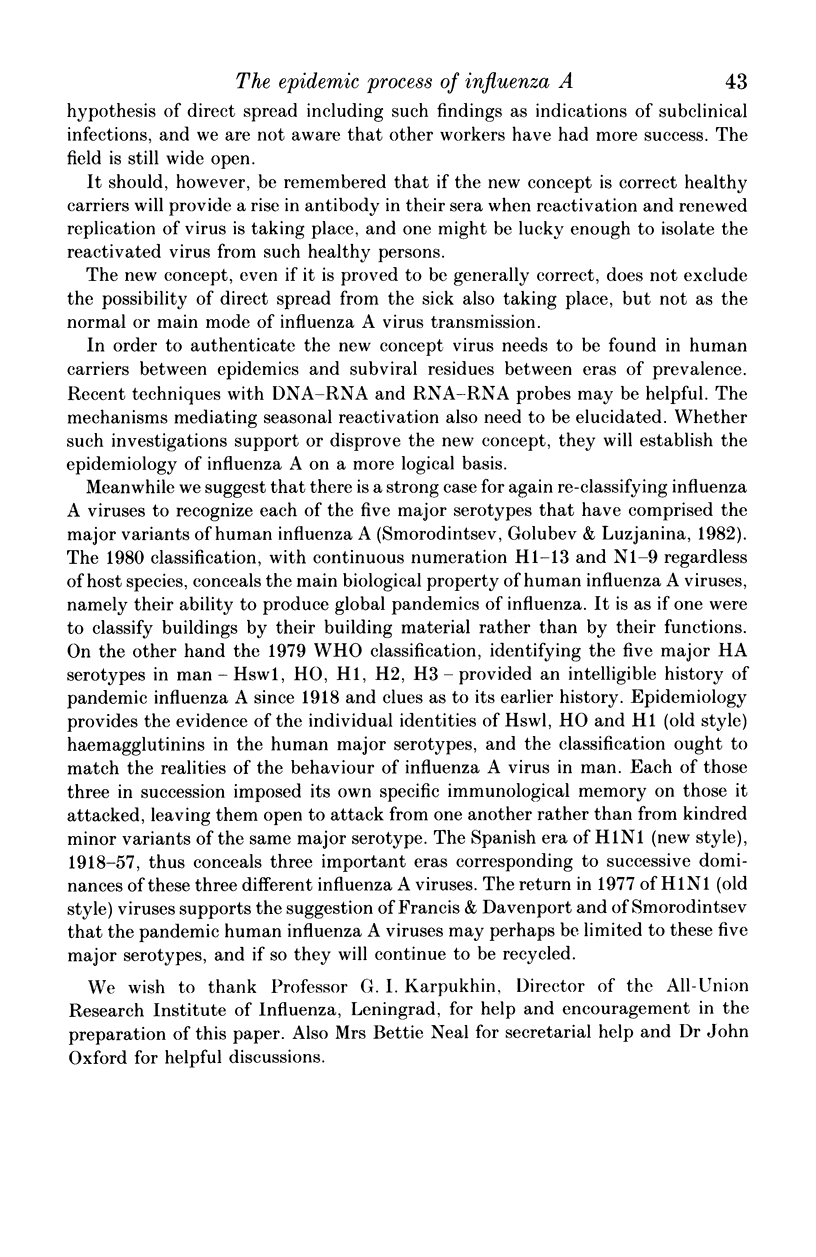
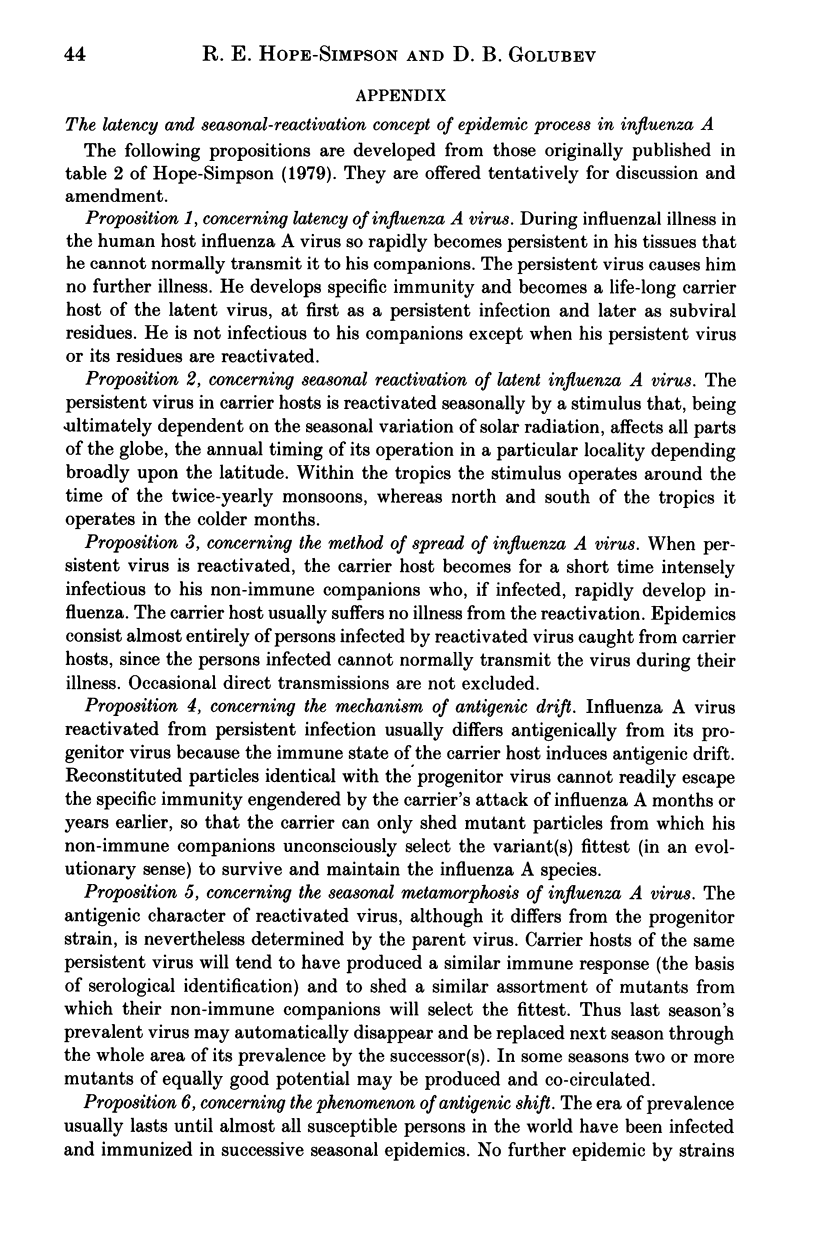
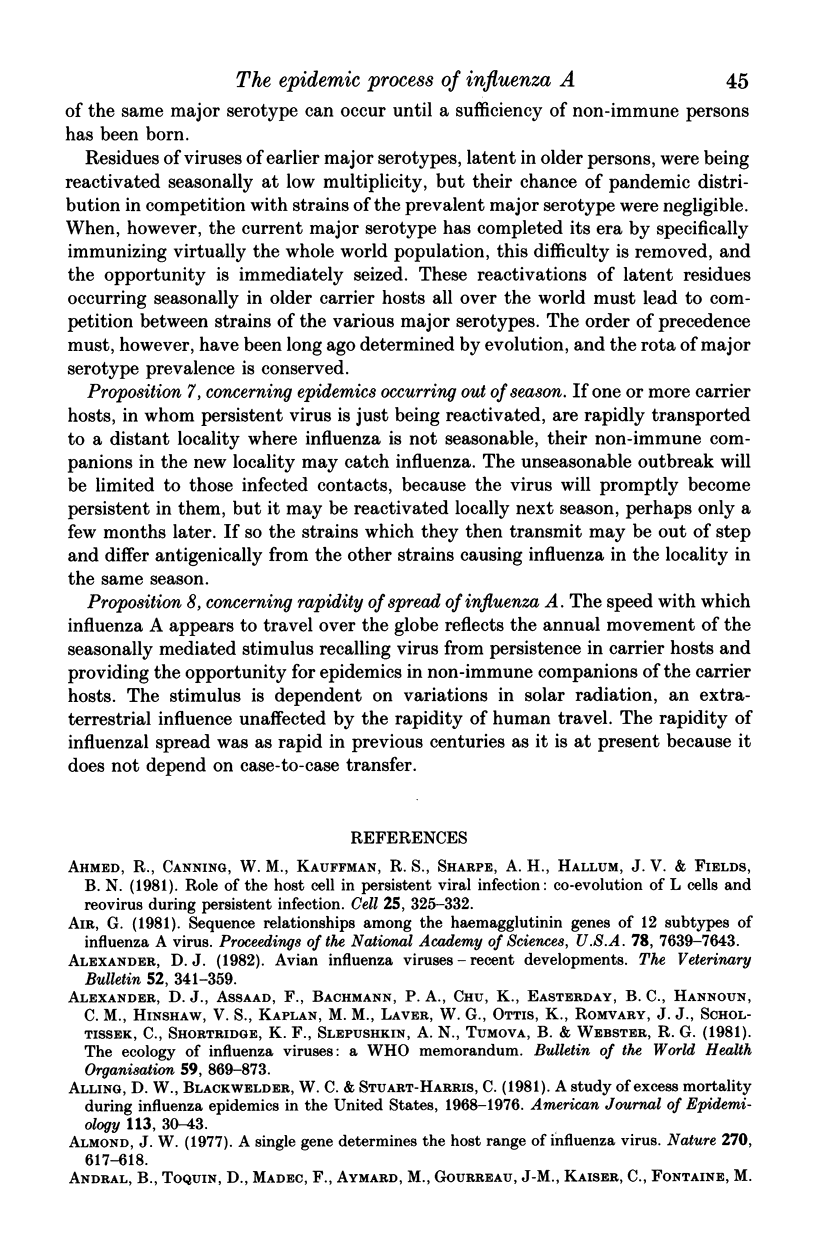
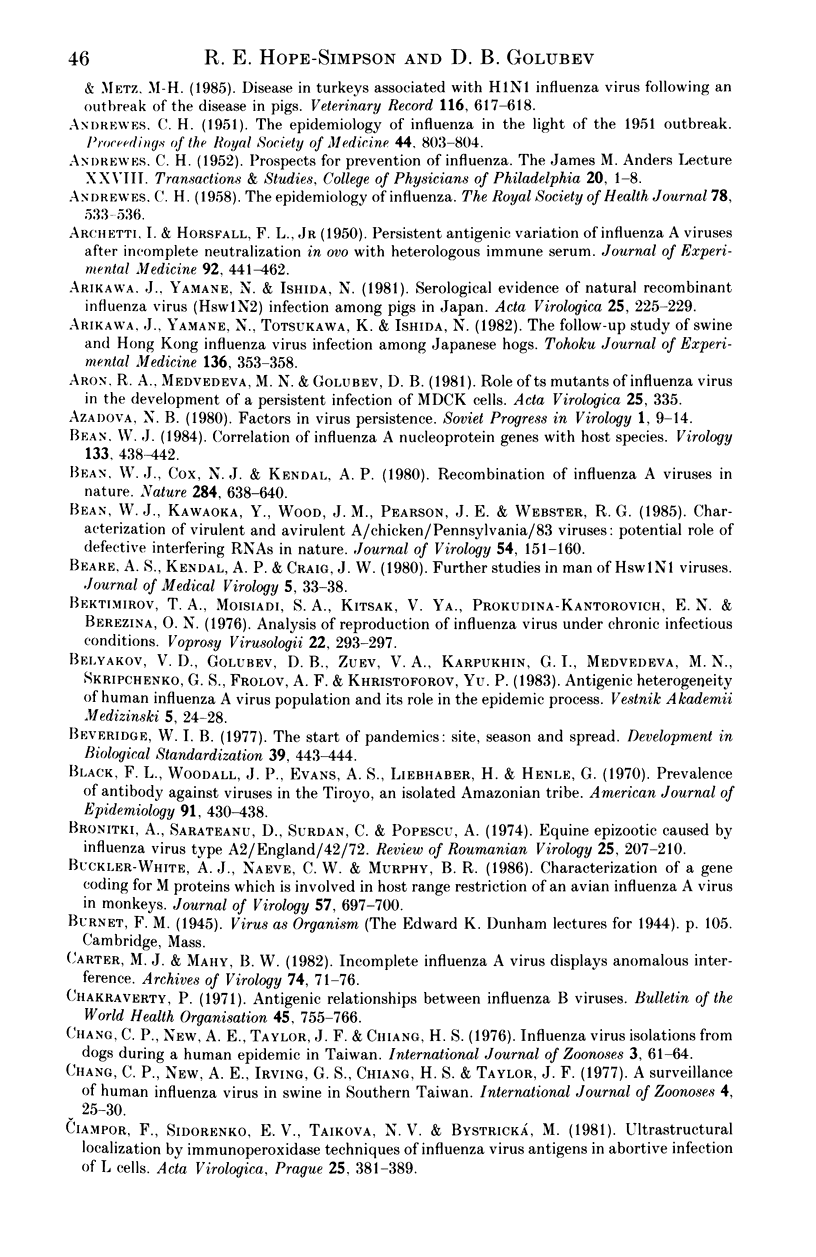
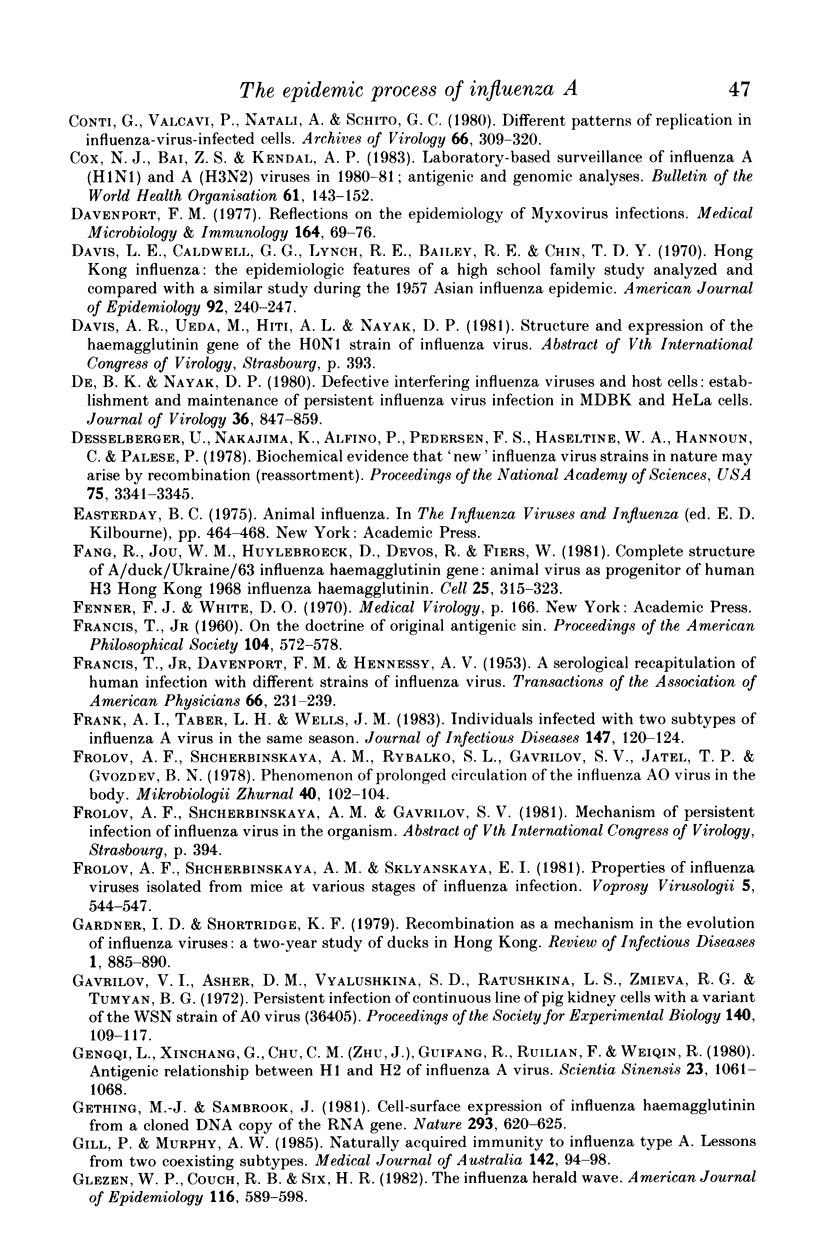
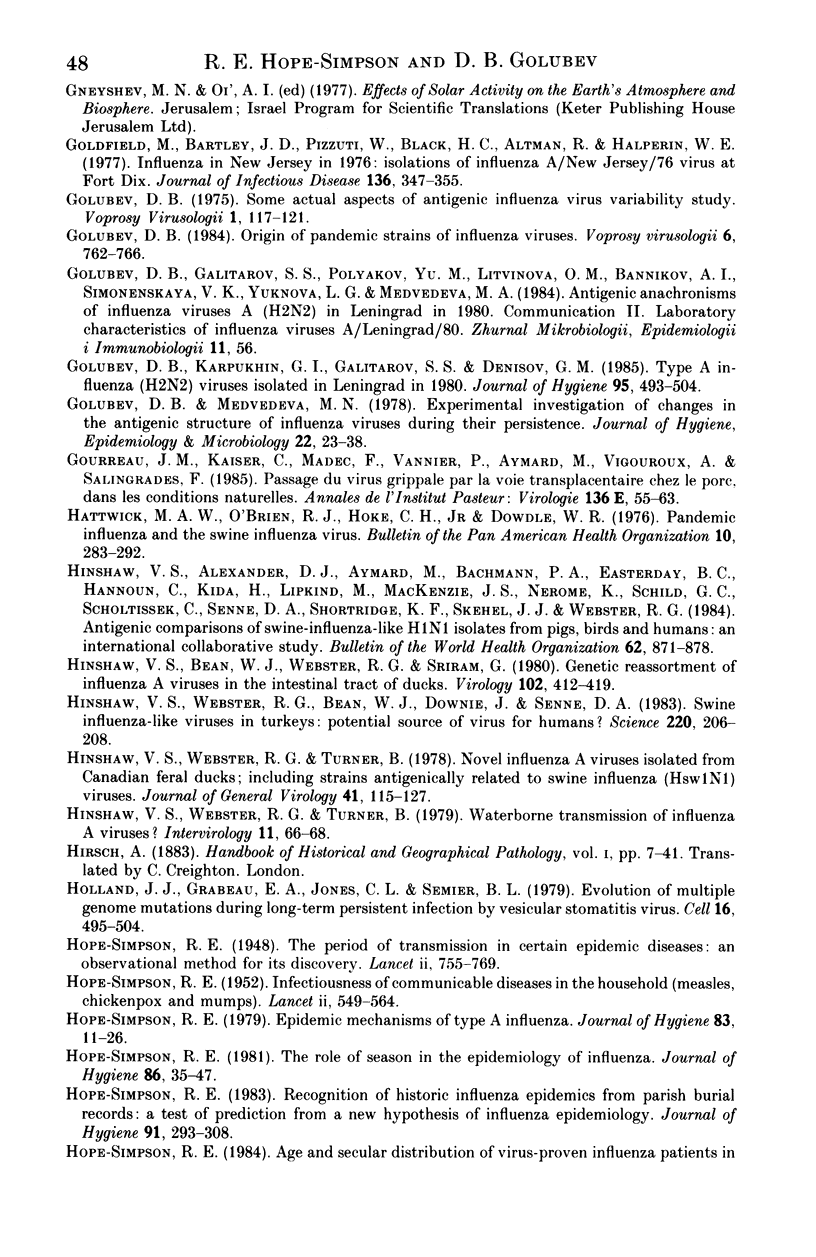

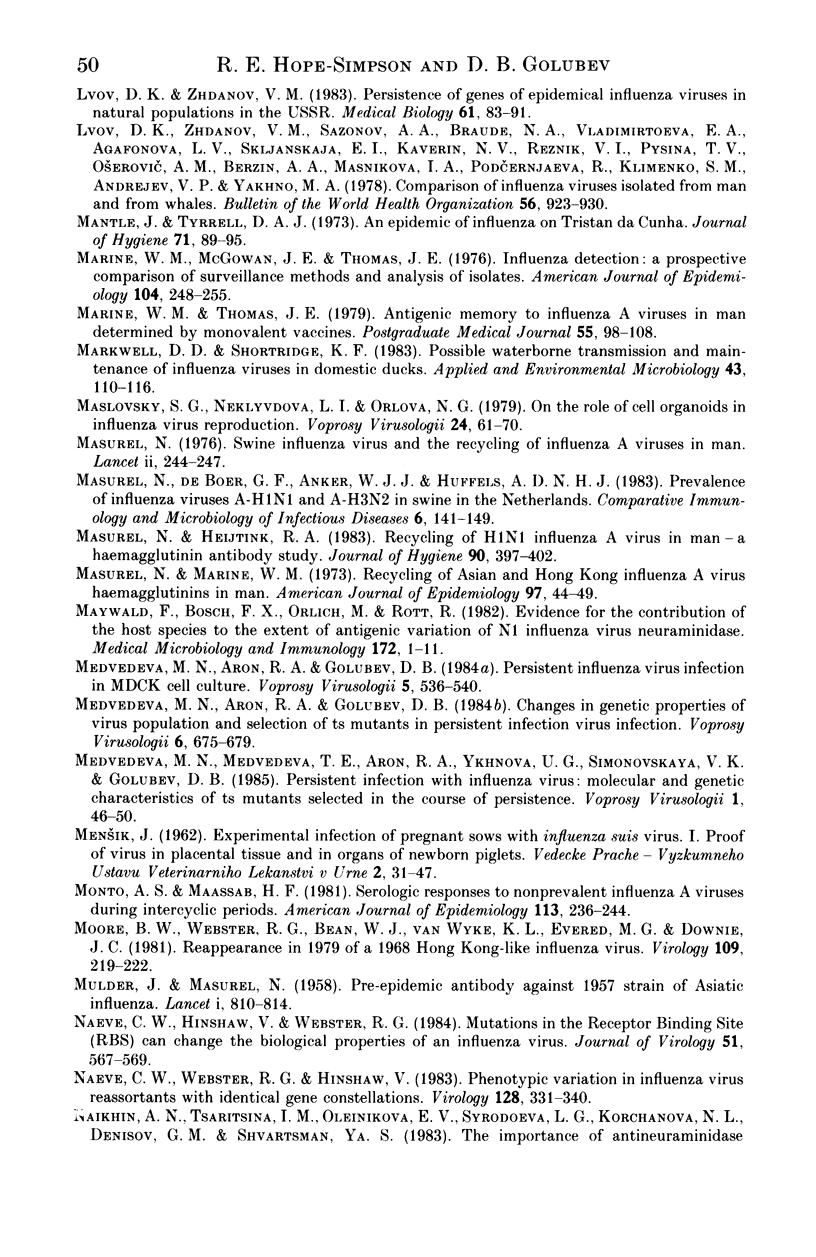
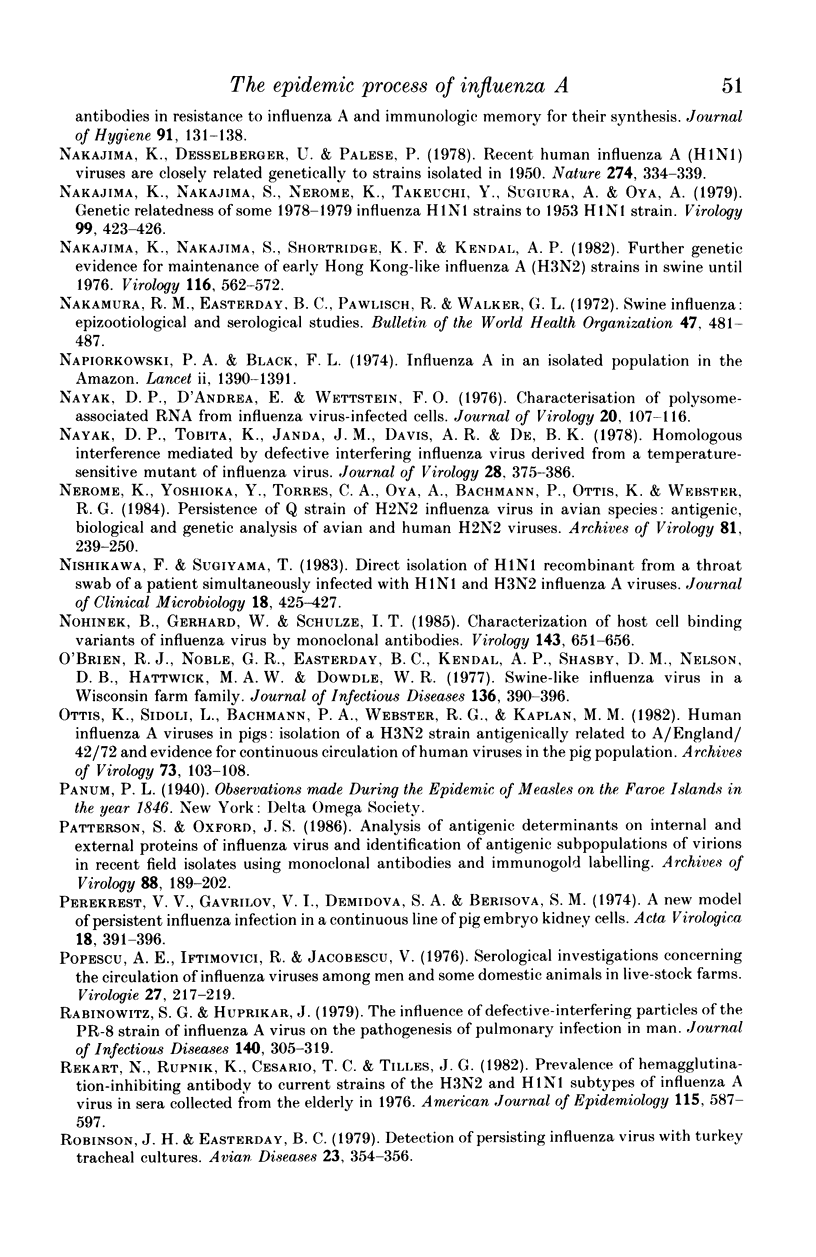
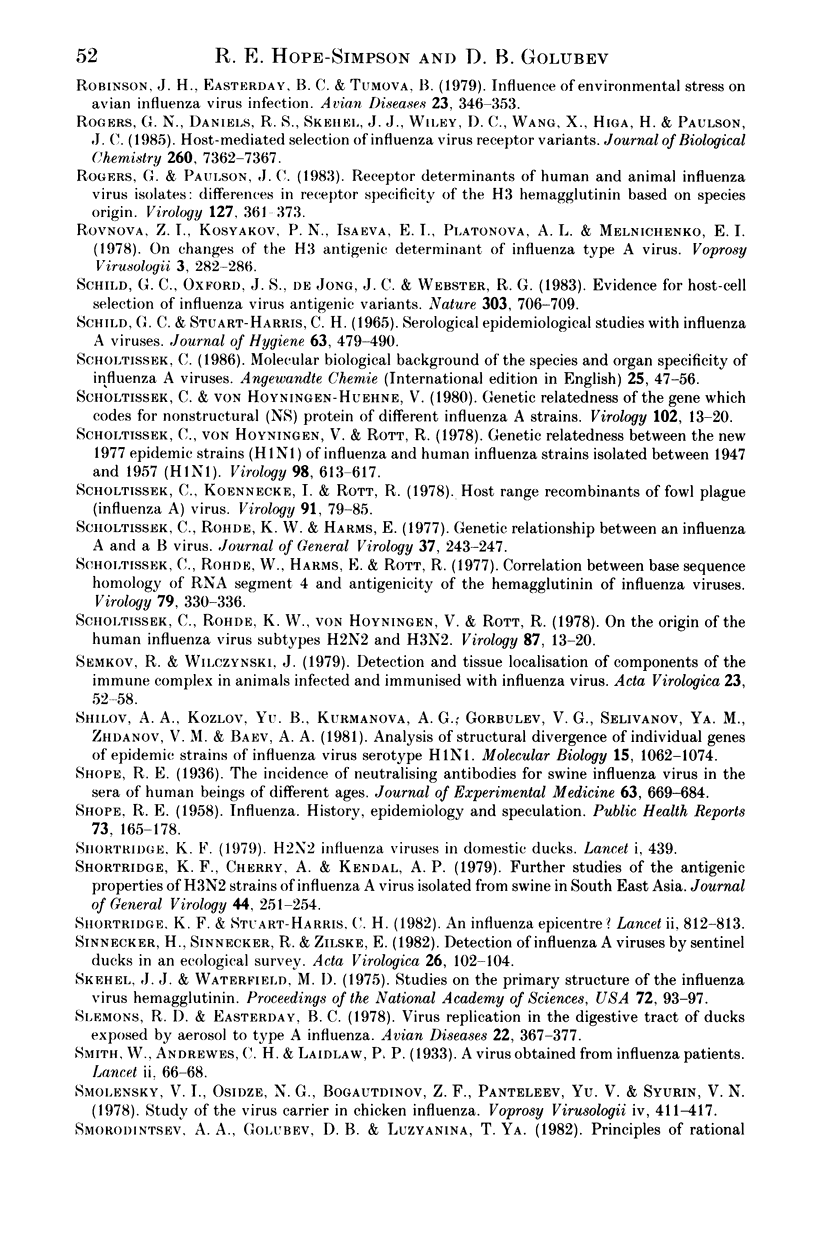
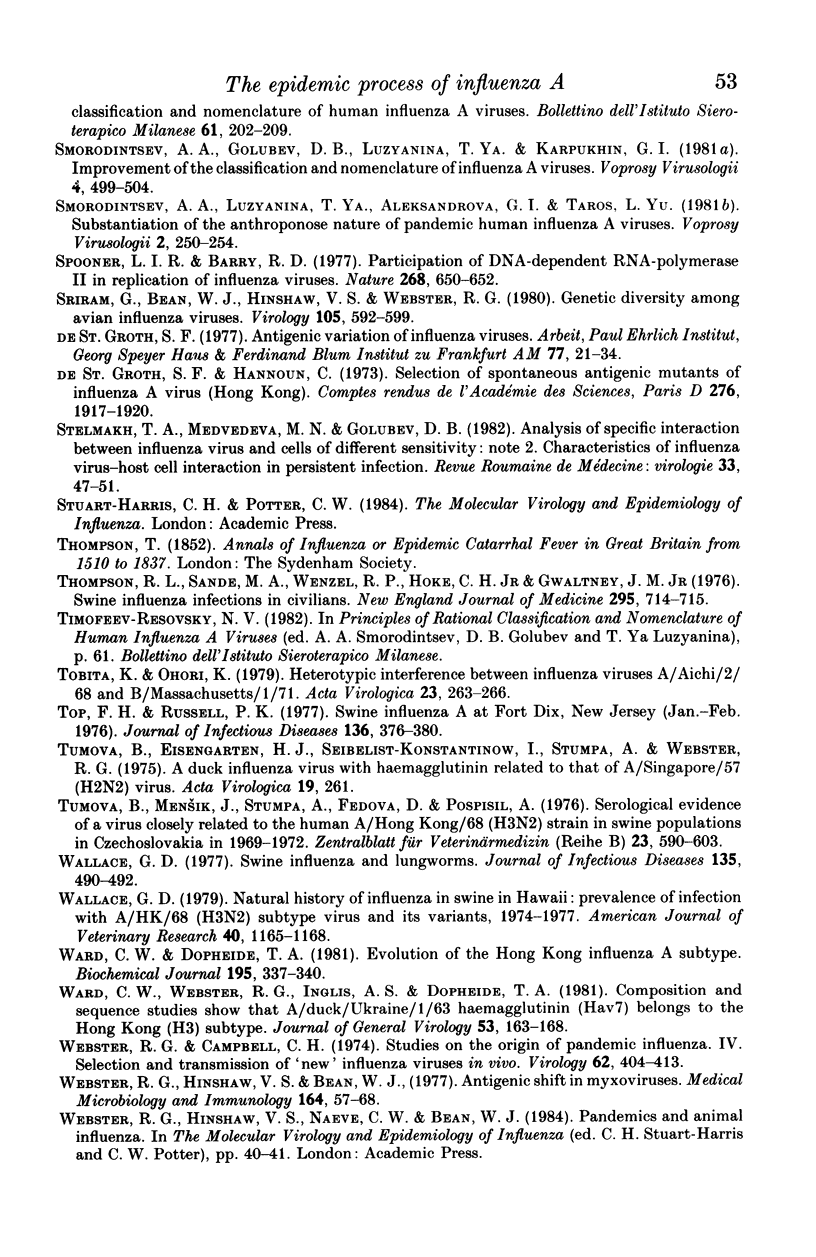
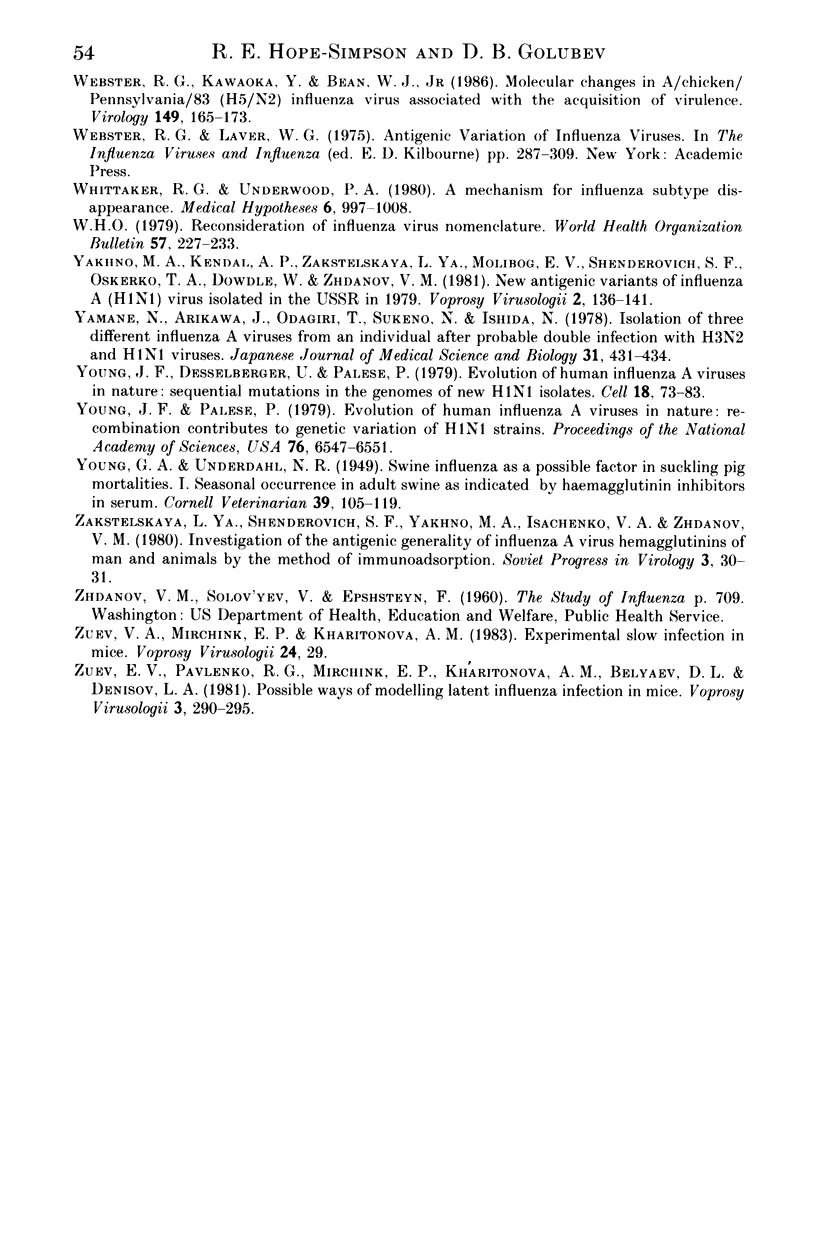
Selected References
These references are in PubMed. This may not be the complete list of references from this article.
- ANDREWES C. H. Epidemiology of influenza in the light of the 1951 outbreak. Proc R Soc Med. 1951 Sep;44(9):803–804. doi: 10.1177/003591575104400905. [DOI] [PMC free article] [PubMed] [Google Scholar]
- ANDREWES C. H. The epidemiology of epidemic influenza. R Soc Health J. 1958 Sep-Oct;78(5):533–536. doi: 10.1177/146642405807800513. [DOI] [PubMed] [Google Scholar]
- ARCHETTI I., HORSFALL F. L., Jr Persistent antigenic variation of influenza A viruses after incomplete neutralization in ovo with heterologous immune serum. J Exp Med. 1950 Nov 1;92(5):441–462. doi: 10.1084/jem.92.5.441. [DOI] [PMC free article] [PubMed] [Google Scholar]
- Ahmed R., Canning W. M., Kauffman R. S., Sharpe A. H., Hallum J. V., Fields B. N. Role of the host cell in persistent viral infection: coevolution of L cells and reovoirus during persistent infection. Cell. 1981 Aug;25(2):325–332. doi: 10.1016/0092-8674(81)90050-7. [DOI] [PubMed] [Google Scholar]
- Air G. M. Sequence relationships among the hemagglutinin genes of 12 subtypes of influenza A virus. Proc Natl Acad Sci U S A. 1981 Dec;78(12):7639–7643. doi: 10.1073/pnas.78.12.7639. [DOI] [PMC free article] [PubMed] [Google Scholar]
- Alling D. W., Blackwelder W. C., Stuart-Harris C. H. A study of excess mortality during influenza epidemics in the United States, 1968-1976. Am J Epidemiol. 1981 Jan;113(1):30–43. doi: 10.1093/oxfordjournals.aje.a113063. [DOI] [PubMed] [Google Scholar]
- Almond J. W. A single gene determines the host range of influenza virus. Nature. 1977 Dec 15;270(5638):617–618. doi: 10.1038/270617a0. [DOI] [PubMed] [Google Scholar]
- Arikawa J., Yamane N., Ishida N. Serological evidence of natural recombinant influenza virus (Hsw1N2) infection among pigs in Japan. Acta Virol. 1981 Jul;25(4):225–229. [PubMed] [Google Scholar]
- Arikawa J., Yamane N., Totsukawa K., Ishida N. The follow-up study of swine and Hong Kong influenza virus infection among Japanese hogs. Tohoku J Exp Med. 1982 Apr;136(4):353–358. doi: 10.1620/tjem.136.353. [DOI] [PubMed] [Google Scholar]
- Aron R. A., Medvedeva M. N., Golubev D. B. Role of ts mutants of influenza virus in the development of a persistent infection of mdck cells. Acta Virol. 1981 Sep;25(5):335–335. [PubMed] [Google Scholar]
- Bean W. J. Correlation of influenza A virus nucleoprotein genes with host species. Virology. 1984 Mar;133(2):438–442. doi: 10.1016/0042-6822(84)90410-0. [DOI] [PubMed] [Google Scholar]
- Bean W. J., Jr, Cox N. J., Kendal A. P. Recombination of human influenza A viruses in nature. Nature. 1980 Apr 17;284(5757):638–640. doi: 10.1038/284638a0. [DOI] [PubMed] [Google Scholar]
- Bean W. J., Kawaoka Y., Wood J. M., Pearson J. E., Webster R. G. Characterization of virulent and avirulent A/chicken/Pennsylvania/83 influenza A viruses: potential role of defective interfering RNAs in nature. J Virol. 1985 Apr;54(1):151–160. doi: 10.1128/jvi.54.1.151-160.1985. [DOI] [PMC free article] [PubMed] [Google Scholar]
- Beare A. S., Kendal A. P., Craig J. W. Further studies in man of Hsw1N1 influenza viruses. J Med Virol. 1980;5(1):33–38. doi: 10.1002/jmv.1890050105. [DOI] [PubMed] [Google Scholar]
- Bektemirov T. A., Moisiadi S. A., Kitsak V. Ia, Prokudina-Kantorovich E. N., Berezina O. N. Analiz reproduktsii virusa grippa v usloviiakh khronicheskoi infektsii. Vopr Virusol. 1976 May-Jun;(3):293–297. [PubMed] [Google Scholar]
- Beveridge W. I. The start of pandemics: site, season and spread. Dev Biol Stand. 1977 Jun 1;39:443–444. [PubMed] [Google Scholar]
- Black F. L., Woodall J. P., Evans A. S., Liebhaber H., Henle G. Prevalence of antibody against viruses in the Tiriyo, an isolated Amazon tribe. Am J Epidemiol. 1970 Apr;91(4):430–438. doi: 10.1093/oxfordjournals.aje.a121153. [DOI] [PubMed] [Google Scholar]
- Bronitki A., Sărăeanu D., Surdan C., Popescu A. Equine epizootic caused by influenza virus type A2/England 42/72. Rev Roum Virol. 1974;25(3):207–210. [PubMed] [Google Scholar]
- Buckler-White A. J., Naeve C. W., Murphy B. R. Characterization of a gene coding for M proteins which is involved in host range restriction of an avian influenza A virus in monkeys. J Virol. 1986 Feb;57(2):697–700. doi: 10.1128/jvi.57.2.697-700.1986. [DOI] [PMC free article] [PubMed] [Google Scholar]
- Carter M. J., Mahy B. W. Incomplete avian influenza A virus displays anomalous interference. Arch Virol. 1982;74(1):71–76. doi: 10.1007/BF01320784. [DOI] [PubMed] [Google Scholar]
- Chang C. P., New A. E., Irving G. S., Chiang H. S., Taylor J. F. A surveillance of human influenza virus in swine in southern Taiwan. Int J Zoonoses. 1977 Jun;4(1):25–30. [PubMed] [Google Scholar]
- Chang C. P., New A. E., Taylor J. F., Chiang H. S. Influenza virus isolations from dogs during a human epidemic in Taiwan. Int J Zoonoses. 1976 Jun;3(1):61–64. [PubMed] [Google Scholar]
- Ciampor F., Sidorenko E. V., Taikova N. V., Bystrická M. Ultrastructural localization by immunoperoxidase techniques of influenza virus antigens in abortive infection of L cells. Acta Virol. 1981 Nov;25(6):381–389. [PubMed] [Google Scholar]
- Conti G., Valcavi P., Natali A., Schito G. C. Different patterns of replication in influenza virus-infected KB cells. Arch Virol. 1980;66(4):309–320. doi: 10.1007/BF01320627. [DOI] [PubMed] [Google Scholar]
- Cox N. J., Bai Z. S., Kendal A. P. Laboratory-based surveillance of influenza A(H1N1) and A(H3N2) viruses in 1980-81: antigenic and genomic analyses. Bull World Health Organ. 1983;61(1):143–152. [PMC free article] [PubMed] [Google Scholar]
- Davenport F. M. Reflections on the epidemiology of myxovirus infections. Med Microbiol Immunol. 1977;164(1-3):69–76. doi: 10.1007/BF02121303. [DOI] [PubMed] [Google Scholar]
- Davis L. E., Caldwell G. G., Lynch R. E., Bailey R. E., Chin T. D. Hong Kong influenza: the epidemiologic features of a high school family study analyzed and compared with a similar study during the 1957 Asian influenza epidemic. Am J Epidemiol. 1970 Oct;92(4):240–247. doi: 10.1093/oxfordjournals.aje.a121203. [DOI] [PubMed] [Google Scholar]
- De B. K., Nayak D. P. Defective interfering influenza viruses and host cells: establishment and maintenance of persistent influenza virus infection in MDBK and HeLa cells. J Virol. 1980 Dec;36(3):847–859. doi: 10.1128/jvi.36.3.847-859.1980. [DOI] [PMC free article] [PubMed] [Google Scholar]
- Desselberger U., Nakajima K., Alfino P., Pedersen F. S., Haseltine W. A., Hannoun C., Palese P. Biochemical evidence that "new" influenza virus strains in nature may arise by recombination (reassortment). Proc Natl Acad Sci U S A. 1978 Jul;75(7):3341–3345. doi: 10.1073/pnas.75.7.3341. [DOI] [PMC free article] [PubMed] [Google Scholar]
- FRANCIS T., Jr, DAVENPORT F. M., HENNESSY A. V. A serological recapitulation of human infection with different strains of influenza virus. Trans Assoc Am Physicians. 1953;66:231–239. [PubMed] [Google Scholar]
- Fang R., Min Jou W., Huylebroeck D., Devos R., Fiers W. Complete structure of A/duck/Ukraine/63 influenza hemagglutinin gene: animal virus as progenitor of human H3 Hong Kong 1968 influenza hemagglutinin. Cell. 1981 Aug;25(2):315–323. doi: 10.1016/0092-8674(81)90049-0. [DOI] [PubMed] [Google Scholar]
- Fazekas de St Groth S. Antigenwandlung von Influenzaviren. Arb Paul Ehrlich Inst Georg Speyer Haus Ferdinand Blum Inst Frankf A M. 1977;(71):21–34. [PubMed] [Google Scholar]
- Fazekas de St Groth S., Hannoun C. Sélection par pression immunologique de mutants dominants du virus de la grippe A (Hong Kong. C R Acad Sci Hebd Seances Acad Sci D. 1973 Mar 19;276(12):1917–1920. [PubMed] [Google Scholar]
- Frank A. L., Taber L. H., Wells J. M. Individuals infected with two subtypes of influenza A virus in the same season. J Infect Dis. 1983 Jan;147(1):120–124. doi: 10.1093/infdis/147.1.120. [DOI] [PubMed] [Google Scholar]
- Frolov A. F., Shcherbinskaia A. M., Rybalko S. L., Gavrilov S. V., Iatel' T. P. Iavlenie dlitel'noi tsirkuliatsii virusa grippa Ao v organizme. Mikrobiol Zh. 1978 Jan-Feb;40(1):102–104. [PubMed] [Google Scholar]
- Frolov A. F., Shcherbinskaia A. M., Sklianskaia E. I. Svoistva virusov grippa, vydelennykh iz organizma myshei na raznykh stadiiakh éksperimental'noi grippoznoi infektsii. Vopr Virusol. 1981 Sep-Oct;(5):544–547. [PubMed] [Google Scholar]
- Gardner I. D., Shortridge K. F. Recombination as a mechanism in the evolution of influenza viruses: a two-year study of ducks in Hong Kong. Rev Infect Dis. 1979 Sep-Oct;1(5):885–890. doi: 10.1093/clinids/1.5.885. [DOI] [PubMed] [Google Scholar]
- Gavrilov V. I., Asher D. M., Vyalushkina S. D., Ratushkina L. S., Zmieva R. G., Tumyan B. G. Persistent infection of continuous line of pig kidney cells with a variant of the WSN strain of influenza A 0 virus. Proc Soc Exp Biol Med. 1972 May;140(1):109–117. doi: 10.3181/00379727-140-36405. [DOI] [PubMed] [Google Scholar]
- Gething M. J., Sambrook J. Cell-surface expression of influenza haemagglutinin from a cloned DNA copy of the RNA gene. Nature. 1981 Oct 22;293(5834):620–625. doi: 10.1038/293620a0. [DOI] [PubMed] [Google Scholar]
- Gill P. W., Murphy A. M. Naturally acquired immunity to influenza type A. Lessons from two coexisting subtypes. Med J Aust. 1985 Jan 21;142(2):94–98. doi: 10.5694/j.1326-5377.1985.tb133042.x. [DOI] [PubMed] [Google Scholar]
- Glezen W. P., Couch R. B., Six H. R. The influenza herald wave. Am J Epidemiol. 1982 Oct;116(4):589–598. doi: 10.1093/oxfordjournals.aje.a113441. [DOI] [PubMed] [Google Scholar]
- Golubev D. B., Karpukhin G. I., Galitarov S. S., Denisov G. M. Type A influenza (H2N2) viruses isolated in Leningrad in 1980. J Hyg (Lond) 1985 Oct;95(2):493–504. doi: 10.1017/s0022172400062914. [DOI] [PMC free article] [PubMed] [Google Scholar]
- Golubev D. B., Medvedeva M. N. Experimental investigation of changes in the antigenic structure of influenza viruses during their persistence. J Hyg Epidemiol Microbiol Immunol. 1978;22(1):23–38. [PubMed] [Google Scholar]
- Golubev D. B. O proiskhozhdenii pandemicheskikh shtammov virusa grippa. Vopr Virusol. 1984 Nov-Dec;29(6):762–766. [PubMed] [Google Scholar]
- Hattwick M. A., O'Brien R. J., Hoke C. H., Jr, Dowdle W. R. Pandemic influenza and the swine influenza virus. Bull Pan Am Health Organ. 1976;10(4):283–292. [PubMed] [Google Scholar]
- Hinshaw V. S., Alexander D. J., Aymard M., Bachmann P. A., Easterday B. C., Hannoun C., Kida H., Lipkind M., MacKenzie J. S., Nerome K. Antigenic comparisons of swine-influenza-like H1N1 isolates from pigs, birds and humans: an international collaborative study. Bull World Health Organ. 1984;62(6):871–878. [PMC free article] [PubMed] [Google Scholar]
- Hinshaw V. S., Bean W. J., Webster R. G., Sriram G. Genetic reassortment of influenza A viruses in the intestinal tract of ducks. Virology. 1980 Apr 30;102(2):412–419. doi: 10.1016/0042-6822(80)90108-7. [DOI] [PubMed] [Google Scholar]
- Hinshaw V. S., Webster R. G., Bean W. J., Downie J., Senne D. A. Swine influenza-like viruses in turkeys: potential source of virus for humans? Science. 1983 Apr 8;220(4593):206–208. doi: 10.1126/science.6298942. [DOI] [PubMed] [Google Scholar]
- Hinshaw V. S., Webster R. G., Turner B. Novel influenza A viruses isolated from Canadian feral ducks: including strains antigenically related to swine influenza (Hsw1N1) viruses. J Gen Virol. 1978 Oct;41(1):115–127. doi: 10.1099/0022-1317-41-1-115. [DOI] [PubMed] [Google Scholar]
- Hinshaw V. S., Webster R. G., Turner B. Water-bone transmission of influenza A viruses? Intervirology. 1979;11(1):66–68. doi: 10.1159/000149014. [DOI] [PubMed] [Google Scholar]
- Holland J. J., Grabau E. A., Jones C. L., Semler B. L. Evolution of multiple genome mutations during long-term persistent infection by vesicular stomatitis virus. Cell. 1979 Mar;16(3):495–504. doi: 10.1016/0092-8674(79)90024-2. [DOI] [PubMed] [Google Scholar]
- Hope-Simpson R. E. Age and secular distributions of virus-proven influenza patients in successive epidemics 1961-1976 in Cirencester: epidemiological significance discussed. J Hyg (Lond) 1984 Jun;92(3):303–336. doi: 10.1017/s0022172400064548. [DOI] [PMC free article] [PubMed] [Google Scholar]
- Hope-Simpson R. E. Epidemic mechanisms of type A influenza. J Hyg (Lond) 1979 Aug;83(1):11–26. doi: 10.1017/s002217240002578x. [DOI] [PMC free article] [PubMed] [Google Scholar]
- Hope-Simpson R. E. Recognition of historic influenza epidemics from parish burial records: a test of prediction from a new hypothesis of influenzal epidemiology. J Hyg (Lond) 1983 Oct;91(2):293–308. doi: 10.1017/s0022172400060319. [DOI] [PMC free article] [PubMed] [Google Scholar]
- Hope-Simpson R. E. The method of transmission of epidemic influenza: further evidence from archival mortality data. J Hyg (Lond) 1986 Apr;96(2):353–375. doi: 10.1017/s0022172400066109. [DOI] [PMC free article] [PubMed] [Google Scholar]
- Hope-Simpson R. E. The role of season in the epidemiology of influenza. J Hyg (Lond) 1981 Feb;86(1):35–47. doi: 10.1017/s0022172400068728. [DOI] [PMC free article] [PubMed] [Google Scholar]
- Housworth J., Langmuir A. D. Excess mortality from epidemic influenza, 1957-1966. Am J Epidemiol. 1974 Jul;100(1):40–48. doi: 10.1093/oxfordjournals.aje.a112007. [DOI] [PubMed] [Google Scholar]
- Huang A. S., Baltimore D. Defective viral particles and viral disease processes. Nature. 1970 Apr 25;226(5243):325–327. doi: 10.1038/226325a0. [DOI] [PubMed] [Google Scholar]
- ISAACS A. The 1951 influenza viruses. Proc R Soc Med. 1951 Sep;44(9):801–803. doi: 10.1177/003591575104400904. [DOI] [PMC free article] [PubMed] [Google Scholar]
- Iakhno M. A., Kendal A., Zakstel'skaia L. Ia, Molibog E. V., Shenderovich S. F. Novye antigennye varianty virusa grippa A(H1N1) obnaruzhennye v SSSR v 1979 g. Vopr Virusol. 1981 Mar-Apr;(2):136–141. [PubMed] [Google Scholar]
- Ivanova N. A., Grinbaum E. B., Taros L. Iu, Luzianina T. Ia, Smorodintsev A. A. Serologicheskoe obosnovanie prodolzhaiushcheisia tsirkuliatsii sredi detei virusov grippa A(HON1) i A(H2N2). Vopr Virusol. 1982 Nov-Dec;27(6):667–671. [PubMed] [Google Scholar]
- Jakab G. J., Astry C. L., Warr G. A. Alveolitis induced by influenza virus. Am Rev Respir Dis. 1983 Oct;128(4):730–739. doi: 10.1164/arrd.1983.128.4.730. [DOI] [PubMed] [Google Scholar]
- Janda J. M., Davis A. R., Nayak D. P., De B. K. Diversity and generation of defective interfering influenza virus particles. Virology. 1979 May;95(1):48–58. doi: 10.1016/0042-6822(79)90400-8. [DOI] [PubMed] [Google Scholar]
- Kantorovich-Prokudina E. N., Semyonova N. P., Berezina O. N., Zhdanov V. M. Gradual changes of influenza virions during passage of undiluted material. J Gen Virol. 1980 Sep;50(1):23–31. doi: 10.1099/0022-1317-50-1-23. [DOI] [PubMed] [Google Scholar]
- Kaplan M. M. The epidemiology of influenza as a zoonosis. Vet Rec. 1982 Apr 24;110(17):395–399. doi: 10.1136/vr.110.17.395. [DOI] [PubMed] [Google Scholar]
- Kendal A. P., Noble G. R., Dowdle W. R. Swine influenza viruses isolated in 1976 from man and pig contain two coexisting subpopulations with antigenically distinguishable hemagglutinins. Virology. 1977 Oct 1;82(1):111–121. doi: 10.1016/0042-6822(77)90037-x. [DOI] [PubMed] [Google Scholar]
- Kendal A. P., Noble G. R., Skehel J. J., Dowdle W. R. Antigenic similarity of influenza A (H1N1) viruses from epidemics in 1977--1978 to "Scandinavian" strains isolated in epidemics of 1950--1951. Virology. 1978 Sep;89(2):632–636. doi: 10.1016/0042-6822(78)90207-6. [DOI] [PubMed] [Google Scholar]
- Klimov A. I., Ghendon Y. Z. Genome analysis of H1N1 influenza virus strains isolated in the U.S.S.R. during an epidemic in 1961-1962. Arch Virol. 1981;70(3):225–232. doi: 10.1007/BF01315129. [DOI] [PubMed] [Google Scholar]
- Koch E. M., Neubert W. J., Hofschneider P. H. Lifelong persistence of paramyxovirus Sendai-6/94 in C129 mice: detection of a latent viral RNA by hybridization with a cloned genomic cDNA probe. Virology. 1984 Jul 15;136(1):78–88. doi: 10.1016/0042-6822(84)90249-6. [DOI] [PubMed] [Google Scholar]
- Krystal M., Buonagurio D., Young J. F., Palese P. Sequential mutations in the NS genes of influenza virus field strains. J Virol. 1983 Feb;45(2):547–554. doi: 10.1128/jvi.45.2.547-554.1983. [DOI] [PMC free article] [PubMed] [Google Scholar]
- Krystal M., Elliott R. M., Benz E. W., Jr, Young J. F., Palese P. Evolution of influenza A and B viruses: conservation of structural features in the hemagglutinin genes. Proc Natl Acad Sci U S A. 1982 Aug;79(15):4800–4804. doi: 10.1073/pnas.79.15.4800. [DOI] [PMC free article] [PubMed] [Google Scholar]
- Lacorte J. G. Persistência do vírus da gripe no cérebro de hamsters inoculados for via entracerebral. Mem Inst Oswaldo Cruz. 1974;72(1-2):129–130. doi: 10.1590/s0074-02761974000100015. [DOI] [PubMed] [Google Scholar]
- Lacorte J. G. Presença do vŕus da gripe no sangue e órgãos de animais inoculados por via intracardíaca. Mem Inst Oswaldo Cruz. 1974;72(1-2):143–145. doi: 10.1590/s0074-02761974000100018. [DOI] [PubMed] [Google Scholar]
- Langmuir A. D., Schoenbaum S. C. The epidemiology of influenza. Hosp Pract. 1976 Oct;11(10):49–56. doi: 10.1080/21548331.1976.11707011. [DOI] [PubMed] [Google Scholar]
- Laver W. G., Webster R. G., Chu C. M. From the National Institutes of Health. Summary of a meeting on the origin of pandemic influenza viruses. J Infect Dis. 1984 Jan;149(1):108–115. doi: 10.1093/infdis/149.1.108. [DOI] [PubMed] [Google Scholar]
- Liu G. Q., Gong X. C., Zhu J. M., Ren G. F., Fan R. L., Ruan W. Q. Antigenic relationship between H1 and H2 of influenza A virus. Sci Sin. 1980 Aug;23(8):1061–1068. [PubMed] [Google Scholar]
- Lvov D. K., Zdanov V. M., Sazonov A. A., Braude N. A., Vladimirtceva E. A., Agafonova L. V., Skljanskaja E. I., Kaverin N. V., Reznik V. I., Pysina T. V. Comparison of influenza viruses isolated from man and from whales. Bull World Health Organ. 1978;56(6):923–930. [PMC free article] [PubMed] [Google Scholar]
- Lvov D. K., Zhdanov V. M. Persistence of genes of epidemical influenza viruses in natural populations in the USSR. Med Biol. 1983 Apr;61(2):83–91. [PubMed] [Google Scholar]
- MULDER J., MASUREL N. Pre-epidemic antibody against 1957 strain of Asiatic influenza in serum of older people living in the Netherlands. Lancet. 1958 Apr 19;1(7025):810–814. doi: 10.1016/s0140-6736(58)91738-0. [DOI] [PubMed] [Google Scholar]
- Mantle J., Tyrrell D. A. An epidemic of influenza on Tristan da Cunha. J Hyg (Lond) 1973 Mar;71(1):89–95. doi: 10.1017/s0022172400046246. [DOI] [PMC free article] [PubMed] [Google Scholar]
- Marine W. M., McGowan J. E., Jr, Thomas J. E. Influenza detection: a prospective comparison of surveillance methods and analysis of isolates. Am J Epidemiol. 1976 Sep;104(3):248–255. doi: 10.1093/oxfordjournals.aje.a112297. [DOI] [PubMed] [Google Scholar]
- Marine W. M., Thomas J. E. Antigenic memory to influenza A viruses in man determined by monovalent vaccines. Postgrad Med J. 1979 Feb;55(640):98–104. doi: 10.1136/pgmj.55.640.98. [DOI] [PMC free article] [PubMed] [Google Scholar]
- Markwell D. D., Shortridge K. F. Possible waterborne transmission and maintenance of influenza viruses in domestic ducks. Appl Environ Microbiol. 1982 Jan;43(1):110–115. doi: 10.1128/aem.43.1.110-115.1982. [DOI] [PMC free article] [PubMed] [Google Scholar]
- Masurel N., Heijtink R. A. Recycling of H1N1 influenza A virus in man--a haemagglutinin antibody study. J Hyg (Lond) 1983 Jun;90(3):397–402. doi: 10.1017/s0022172400029028. [DOI] [PMC free article] [PubMed] [Google Scholar]
- Masurel N., Marine W. M. Recycling of Asian and Hong Kong influenza A virus hemagglutinins in man. Am J Epidemiol. 1973 Jan;97(1):44–49. doi: 10.1093/oxfordjournals.aje.a121483. [DOI] [PubMed] [Google Scholar]
- Masurel N. Swine influenza virus and the recycling of influenza-A viruses in man. Lancet. 1976 Jul 31;2(7979):244–247. doi: 10.1016/s0140-6736(76)91038-2. [DOI] [PubMed] [Google Scholar]
- Masurel N., de Boer G. F., Anker W. J., Huffels A. D. Prevalence of influenza viruses A-H1N1 and A-H3N2 in swine in the Netherlands. Comp Immunol Microbiol Infect Dis. 1983;6(2):141–149. doi: 10.1016/0147-9571(83)90005-x. [DOI] [PubMed] [Google Scholar]
- Maywald F., Bosch F. X., Orlich M., Rott R. Evidence for the contribution of the host species to the extent of antigenic variation of N1 influenza virus neuraminidase. Med Microbiol Immunol. 1983;172(1):1–11. doi: 10.1007/BF02123672. [DOI] [PubMed] [Google Scholar]
- Medvedeva M. N., Aron R. A., Golubev D. B. Izmenenie geneticheskikh svoistv virusnoi populiatsii i selektsiia ts-mutantov pri persistentnoi infektsii virusa grippa. Vopr Virusol. 1984 Nov-Dec;29(6):675–679. [PubMed] [Google Scholar]
- Medvedeva M. N., Aron R. A., Golubev D. B. Persistentnaia infektsiia virusa grippa v kul'ture kletok MDCK. Vopr Virusol. 1984 Sep-Oct;29(5):536–539. [PubMed] [Google Scholar]
- Medvedeva M. N., Medvedeva T. E., Aron R. A., Iukhnova L. G., Simanovskaia V. K. Persistentnaia infektsiia virusa grippa. Molekuliarno-geneticheskaia kharakteristika ts-mutantov, selektsioniruiushchikhsia v protsesse persistentsii. Vopr Virusol. 1985 Jan-Feb;30(1):46–50. [PubMed] [Google Scholar]
- Monto A. S., Maassab H. F. Serologic responses to nonprevalent influenza A viruses during intercyclic periods. Am J Epidemiol. 1981 Mar;113(3):236–244. doi: 10.1093/oxfordjournals.aje.a113092. [DOI] [PubMed] [Google Scholar]
- Moore B. W., Webster R. G., Bean W. J., van Wyke K. L., Laver W. G., Evered M. G., Downie J. C. Reappearance in 1979 of a 1968 Hong Kong-like influenza virus. Virology. 1981 Feb;109(1):219–222. doi: 10.1016/0042-6822(81)90492-x. [DOI] [PubMed] [Google Scholar]
- Naeve C. W., Hinshaw V. S., Webster R. G. Mutations in the hemagglutinin receptor-binding site can change the biological properties of an influenza virus. J Virol. 1984 Aug;51(2):567–569. doi: 10.1128/jvi.51.2.567-569.1984. [DOI] [PMC free article] [PubMed] [Google Scholar]
- Naeve C. W., Webster R. G., Hinshaw V. S. Phenotypic variation in influenza virus reassortants with identical gene constellations. Virology. 1983 Jul 30;128(2):331–340. doi: 10.1016/0042-6822(83)90260-x. [DOI] [PubMed] [Google Scholar]
- Nakajima K., Desselberger U., Palese P. Recent human influenza A (H1N1) viruses are closely related genetically to strains isolated in 1950. Nature. 1978 Jul 27;274(5669):334–339. doi: 10.1038/274334a0. [DOI] [PubMed] [Google Scholar]
- Nakajima K., Nakajima S., Nerome K., Takeuchi Y., Sugiura A., Oya A. Genetic relatedness of some 1978--1979 influenza H1N1 strains to 1953 H1N1 strain. Virology. 1979 Dec;99(2):423–426. doi: 10.1016/0042-6822(79)90022-9. [DOI] [PubMed] [Google Scholar]
- Nakajima K., Nakajima S., Shortridge K. F., Kendal A. P. Further genetic evidence for maintenance of early Hong Kong-like influenza A(H3N2) strains in swine until 1976. Virology. 1982 Jan 30;116(2):562–572. doi: 10.1016/0042-6822(82)90148-9. [DOI] [PubMed] [Google Scholar]
- Nakamura R. M., Easterday B. C., Pawlisch R., Walker G. L. Swine influenza: epizootiological and serological studies. Bull World Health Organ. 1972;47(4):481–487. [PMC free article] [PubMed] [Google Scholar]
- Napiorkowski P. A., Black F. L. Letter: Influenza A in an isolated population in the Amazon. Lancet. 1974 Dec 7;2(7893):1390–1391. doi: 10.1016/s0140-6736(74)92265-x. [DOI] [PubMed] [Google Scholar]
- Nayak D. P., D'Andrea E., Wettstein F. O. Characterization of polysome-associated RNA from influenza virus-infected cells. J Virol. 1976 Oct;20(1):107–116. doi: 10.1128/jvi.20.1.107-116.1976. [DOI] [PMC free article] [PubMed] [Google Scholar]
- Nayak D. P., Tobita K., Janda J. M., Davis A. R., De B. K. Homologous interference mediated by defective interfering influenza virus derived from a temperature-sensitive mutant of influenza virus. J Virol. 1978 Oct;28(1):375–386. doi: 10.1128/jvi.28.1.375-386.1978. [DOI] [PMC free article] [PubMed] [Google Scholar]
- Nerome K., Yoshioka Y., Torres C. A., Oya A., Bachmann P., Ottis K., Webster R. G. Persistence of Q strain of H2N2 influenza virus in avian species: antigenic, biological and genetic analysis of avian and human H2N2 viruses. Arch Virol. 1984;81(3-4):239–250. doi: 10.1007/BF01309996. [DOI] [PubMed] [Google Scholar]
- Nishikawa F., Sugiyama T. Direct isolation of H1N2 recombinant virus from a throat swab of a patient simultaneously infected with H1N1 and H3N2 influenza A viruses. J Clin Microbiol. 1983 Aug;18(2):425–427. doi: 10.1128/jcm.18.2.425-427.1983. [DOI] [PMC free article] [PubMed] [Google Scholar]
- Nohinek B., Gerhard W., Schulze I. T. Characterization of host cell binding variants of influenza virus by monoclonal antibodies. Virology. 1985 Jun;143(2):651–656. doi: 10.1016/0042-6822(85)90407-6. [DOI] [PubMed] [Google Scholar]
- Ottis K., Sidoli L., Bachmann P. A., Webster R. G., Kaplan M. M. Human influenza A viruses in pigs: isolation of a H3N2 strain antigenically related to A/England/42/72 and evidence for continuous circulation of human viruses in the pig population. Arch Virol. 1982;73(2):103–108. doi: 10.1007/BF01314719. [DOI] [PubMed] [Google Scholar]
- Patterson S., Oxford J. S. Analysis of antigenic determinants on internal and external proteins of influenza virus and identification of antigenic subpopulations of virions in recent field isolates using monoclonal antibodies and immunogold labelling. Arch Virol. 1986;88(3-4):189–202. doi: 10.1007/BF01310874. [DOI] [PubMed] [Google Scholar]
- Popescu A. E., Iftimovici R., Iacobescu V., Gianga I., Tudor G., Milici V., Ghila I., Bogos L., Ignătescu B. Serological investigations concerning the circulation of influenza viruses among men and some domestic animals in live-stock farms. Virologie. 1976 Jul-Sep;27(3):217–219. [PubMed] [Google Scholar]
- Rabinowitz S. G., Huprikar J. The influence of defective-interfering particles of the PR-8 strain of influenza A virus on the pathogenesis of pulmonary infection in mice. J Infect Dis. 1979 Sep;140(3):305–315. doi: 10.1093/infdis/140.3.305. [DOI] [PubMed] [Google Scholar]
- Rekart M., Rupnik K., Cesario T. C., Tilles J. G. Prevalence of hemagglutination inhibition antibody to current strains of the H3N2 and H1N1 subtypes of influenza A virus in sera collected from the elderly in 1976. Am J Epidemiol. 1982 Apr;115(4):587–597. doi: 10.1093/oxfordjournals.aje.a113340. [DOI] [PubMed] [Google Scholar]
- Rogers G. N., Daniels R. S., Skehel J. J., Wiley D. C., Wang X. F., Higa H. H., Paulson J. C. Host-mediated selection of influenza virus receptor variants. Sialic acid-alpha 2,6Gal-specific clones of A/duck/Ukraine/1/63 revert to sialic acid-alpha 2,3Gal-specific wild type in ovo. J Biol Chem. 1985 Jun 25;260(12):7362–7367. [PubMed] [Google Scholar]
- Rogers G. N., Paulson J. C. Receptor determinants of human and animal influenza virus isolates: differences in receptor specificity of the H3 hemagglutinin based on species of origin. Virology. 1983 Jun;127(2):361–373. doi: 10.1016/0042-6822(83)90150-2. [DOI] [PubMed] [Google Scholar]
- Rovnova Z. I., Kosiakov P. N., Isaeva E. I., Platonova A. L., Mel'nichenko E. I. Ob izmenenii antigennoi determinanty H3 u virusa grippa tipa A. Vopr Virusol. 1978 May-Jun;(3):282–286. [PubMed] [Google Scholar]
- SHOPE R. E. Influenza: history, epidemiology, and speculation. Public Health Rep. 1958 Feb;73(2):165–178. [PMC free article] [PubMed] [Google Scholar]
- SIMPSON R. E. H. Infectiousness of communicable diseases in the household (measles, chickenpox, and mumps). Lancet. 1952 Sep 20;2(6734):549–554. doi: 10.1016/s0140-6736(52)91357-3. [DOI] [PubMed] [Google Scholar]
- SIMPSON R. E. H. The period of transmission in certain epidemic diseases; an observational method for its discovery. Lancet. 1948 Nov 13;2(6533):755–760. doi: 10.1016/s0140-6736(48)91328-2. [DOI] [PubMed] [Google Scholar]
- Schild G. C., Oxford J. S., de Jong J. C., Webster R. G. Evidence for host-cell selection of influenza virus antigenic variants. Nature. 1983 Jun 23;303(5919):706–709. doi: 10.1038/303706a0. [DOI] [PubMed] [Google Scholar]
- Schild G. C., Stuart-Harris C. H. Serological epidemiological studies with influenza A viruses. J Hyg (Lond) 1965 Dec;63(4):479–490. doi: 10.1017/s0022172400045368. [DOI] [PMC free article] [PubMed] [Google Scholar]
- Scholtissek C., Koennecke I., Rott R. Host range recombinants of fowl plague (influenza A) virus. Virology. 1978 Nov;91(1):79–85. doi: 10.1016/0042-6822(78)90356-2. [DOI] [PubMed] [Google Scholar]
- Scholtissek C., Rohde W., Harms E. Genetic relationship between an influenza A and a B virus. J Gen Virol. 1977 Nov;37(2):243–247. doi: 10.1099/0022-1317-37-2-243. [DOI] [PubMed] [Google Scholar]
- Scholtissek C., Rohde W., Harms E., Rott R. Correlation between base sequence homology of RNA segment 4 and antigenicity of the hemagglutinin of influenza viruses. Virology. 1977 Jun 15;79(2):330–336. doi: 10.1016/0042-6822(77)90360-9. [DOI] [PubMed] [Google Scholar]
- Scholtissek C., Rohde W., Von Hoyningen V., Rott R. On the origin of the human influenza virus subtypes H2N2 and H3N2. Virology. 1978 Jun 1;87(1):13–20. doi: 10.1016/0042-6822(78)90153-8. [DOI] [PubMed] [Google Scholar]
- Scholtissek C., von Hoyningen-Huene V. Genetic relatedness of the gene which codes for the nonstructural (NS) protein of different influenza A strains. Virology. 1980 Apr 15;102(1):13–20. doi: 10.1016/0042-6822(80)90065-3. [DOI] [PubMed] [Google Scholar]
- Scholtissek C., von Hoyningen V., Rott R. Genetic relatedness between the new 1977 epidemic strains (H1N1) of influenza and human influenza strains isolated between 1947 and 1957 (H1N1). Virology. 1978 Sep;89(2):613–617. doi: 10.1016/0042-6822(78)90203-9. [DOI] [PubMed] [Google Scholar]
- Semkow R., Wilczyński J. Detection and tissue localization of components of the immune complex in animals infected and immunized with influenza virus. Acta Virol. 1979 Jan;23(1):52–58. [PubMed] [Google Scholar]
- Shortridge K. F., Cherry A., Kendal A. P. Further studies of the antigenic properties of H3N2 strains of influenza A isolated from swine in South East Asia. J Gen Virol. 1979 Jul;44(1):251–254. doi: 10.1099/0022-1317-44-1-251. [DOI] [PubMed] [Google Scholar]
- Shortridge K. F., Stuart-Harris C. H. An influenza epicentre? Lancet. 1982 Oct 9;2(8302):812–813. doi: 10.1016/s0140-6736(82)92693-9. [DOI] [PubMed] [Google Scholar]
- Sinnecker H., Sinnecker R., Zilske E. Detection of influenza A viruses by sentinel domestic ducks in an ecological survey. Acta Virol. 1982 Jan;26(1-2):102–104. [PubMed] [Google Scholar]
- Skehel J. J., Waterfield M. D. Studies on the primary structure of the influenza virus hemagglutinin. Proc Natl Acad Sci U S A. 1975 Jan;72(1):93–97. doi: 10.1073/pnas.72.1.93. [DOI] [PMC free article] [PubMed] [Google Scholar]
- Slemons R. D., Easterday B. C. Virus replication in the digestive tract of ducks exposed by aerosol to type-A influenza. Avian Dis. 1978 Jul-Sep;22(3):367–377. [PubMed] [Google Scholar]
- Smolenskii V. I., Osidze N. G., Bogautdinov Z. F., Panteleev Iu V., Siurin V. N. Izuchenie virusonositel'stva pri grippe kur. Vopr Virusol. 1978 Jul-Aug;(4):411–417. [PubMed] [Google Scholar]
- Spooner L. L., Barry R. D. Participation of DNA-dependent RNA polymerase II in replication of influenza viruses. Nature. 1977 Aug 18;268(5621):650–652. doi: 10.1038/268650a0. [DOI] [PubMed] [Google Scholar]
- Sriram G., Bean W. J., Jr, Hinshaw V. S., Webster R. G. Genetic diversity among avian influenza viruses. Virology. 1980 Sep;105(2):592–599. doi: 10.1016/0042-6822(80)90059-8. [DOI] [PubMed] [Google Scholar]
- Stelmakh T. A., Medvedeva M. N., Golubev D. B. Analysis of specific interactions influenza virus and cells of different sensitivity. Note 2. Characteristics of influenza virus-host cell interaction in persistent infection. Virologie. 1982 Jan-Mar;33(1):47–51. [PubMed] [Google Scholar]
- Thompson R. L., Sande M. A., Wenzel R. P., Hoke C. H., Jr, Gwaltney J. M., Jr Swine-influenza infection in civilians. Report of two cases. N Engl J Med. 1976 Sep 23;295(13):714–715. doi: 10.1056/NEJM197609232951307. [DOI] [PubMed] [Google Scholar]
- Tobita K., Ohori K. Heterotypic interference between influenza viruses A/Aichi/2/68 and B/Massachusetts/1/71. Acta Virol. 1979 May;23(3):263–266. [PubMed] [Google Scholar]
- Tumová B., Eisengarten H. J., Siebelist-Konstantinow I., Stumpa A., Webster R. G. A duck influenza virus with haemagglutinin related to that of A/Singapore/57 (H2N2) virus. Acta Virol. 1975 May;19(3):261–261. [PubMed] [Google Scholar]
- Tũmová B., Mensík J., Stumpa A., Fedová D., Pospísil Z. Serological evidence and isolation of a virus closely related to the human A/Hong Kong/68 (H3N2) strain in swine populations in Czechoslovakia in 1969-1972. Zentralbl Veterinarmed B. 1976 Aug;23(7):590–563. [PubMed] [Google Scholar]
- Wallace G. D. Natural history of influenza in swine in Hawaii: prevalence of infection with A/Hong Kong/68 (H3N2) subtype virus and its variants, 1974-1977. Am J Vet Res. 1979 Aug;40(8):1165–1168. [PubMed] [Google Scholar]
- Wallace G. W. Swine influenza and lungworms. J Infect Dis. 1977 Mar;135(3):490–492. doi: 10.1093/infdis/135.3.490. [DOI] [PubMed] [Google Scholar]
- Ward C. W., Dopheide T. A. Evolution of the Hong Kong influenza A sub-type. Structural relationships between the haemagglutinin from A/duck/Ukraine/1/63 (Hav 7) and the Hong Kong (H3) haemagglutinins. Biochem J. 1981 Apr 1;195(1):337–340. doi: 10.1042/bj1950337. [DOI] [PMC free article] [PubMed] [Google Scholar]
- Ward C. W., Webster R. G., Inglis A. S., Dopheide T. A. Composition and sequence studies show that A/duck/Ukraine/1/63 haemagglutinin (Hav7) belongs to the Hong Kong (H3) subtype. J Gen Virol. 1981 Mar;53(Pt 1):163–168. doi: 10.1099/0022-1317-53-1-163. [DOI] [PubMed] [Google Scholar]
- Webster R. G., Campbell C. H. Studies on the origin of pandemic influenza. IV. Selection and transmission of "new" influenza viruses in vivo. Virology. 1974 Dec;62(2):404–413. doi: 10.1016/0042-6822(74)90402-4. [DOI] [PubMed] [Google Scholar]
- Webster R. G., Hinshaw V. S., Bean W. J., Jr Antigenic shift in myxoviruses. Med Microbiol Immunol. 1977;164(1-3):57–68. doi: 10.1007/BF02121302. [DOI] [PubMed] [Google Scholar]
- Webster R. G., Kawaoka Y., Bean W. J., Jr Molecular changes in A/Chicken/Pennsylvania/83 (H5N2) influenza virus associated with acquisition of virulence. Virology. 1986 Mar;149(2):165–173. doi: 10.1016/0042-6822(86)90118-2. [DOI] [PubMed] [Google Scholar]
- Whittaker R. G., Underwood P. A. A mechanism for influenza subtype disappearance. Med Hypotheses. 1980 Oct;6(10):997–1008. doi: 10.1016/0306-9877(80)90014-6. [DOI] [PubMed] [Google Scholar]
- Yamane N., Arikawa J., Odagiri T., Sukeno N., Ishida N. Isolation of three different influenza A viruses from an individual after probable double infection with H3N2 and H1N1 viruses. Jpn J Med Sci Biol. 1978 Oct-Dec;31(5-6):431–434. doi: 10.7883/yoken1952.31.431. [DOI] [PubMed] [Google Scholar]
- Young J. F., Desselberger U., Palese P. Evolution of human influenza A viruses in nature: sequential mutations in the genomes of new H1N1. Cell. 1979 Sep;18(1):73–83. doi: 10.1016/0092-8674(79)90355-6. [DOI] [PubMed] [Google Scholar]
- Young J. F., Palese P. Evolution of human influenza A viruses in nature: recombination contributes to genetic variation of H1N1 strains. Proc Natl Acad Sci U S A. 1979 Dec;76(12):6547–6551. doi: 10.1073/pnas.76.12.6547. [DOI] [PMC free article] [PubMed] [Google Scholar]
- Zuev V. A., Mirchink E. P., Kharitonova A. M. Eksperimental'naia medlennaia grippoznaia infektsiia u myshei. Vopr Virusol. 1983 Jan-Feb;28(1):24–29. [PubMed] [Google Scholar]
- von Hoyningen-Huene V., Scholtissek C. Low genetic mixing between avian influenza viruses of different geographic regions. Arch Virol. 1983;76(1):63–67. doi: 10.1007/BF01315704. [DOI] [PubMed] [Google Scholar]


